Thank you for visiting nature.com. You are using a browser version with limited support for CSS. To obtain the best experience, we recommend you use a more up to date browser (or turn off compatibility mode in Internet Explorer). In the meantime, to ensure continued support, we are displaying the site without styles and JavaScript.
- View all journals
- My Account Login
- Explore content
- About the journal
- Publish with us
- Sign up for alerts
- Data Descriptor
- Open access
- Published: 23 September 2021

A database of travel-related behaviors and attitudes before, during, and after COVID-19 in the United States
- Rishabh Singh Chauhan ORCID: orcid.org/0000-0001-7188-557X 1 ,
- Matthew Wigginton Bhagat-Conway ORCID: orcid.org/0000-0002-1210-2982 2 ,
- Denise Capasso da Silva ORCID: orcid.org/0000-0003-1414-8439 3 ,
- Deborah Salon ORCID: orcid.org/0000-0002-2240-8408 2 ,
- Ali Shamshiripour 1 ,
- Ehsan Rahimi ORCID: orcid.org/0000-0002-8649-7542 1 ,
- Sara Khoeini 3 ,
- Abolfazl (Kouros) Mohammadian ORCID: orcid.org/0000-0003-3595-3664 1 ,
- Sybil Derrible ORCID: orcid.org/0000-0002-2939-6016 1 &
- Ram Pendyala 3
Scientific Data volume 8 , Article number: 245 ( 2021 ) Cite this article
9276 Accesses
18 Citations
2 Altmetric
Metrics details
- Interdisciplinary studies
- Research data
The COVID-19 pandemic has impacted billions of people around the world. To capture some of these impacts in the United States, we are conducting a nationwide longitudinal survey collecting information about activity and travel-related behaviors and attitudes before, during, and after the COVID-19 pandemic. The survey questions cover a wide range of topics including commuting, daily travel, air travel, working from home, online learning, shopping, and risk perception, along with attitudinal, socioeconomic, and demographic information. The survey is deployed over multiple waves to the same respondents to monitor how behaviors and attitudes evolve over time. Version 1.0 of the survey contains 8,723 responses that are publicly available. This article details the methodology adopted for the collection, cleaning, and processing of the data. In addition, the data are weighted to be representative of national and regional demographics. This survey dataset can aid researchers, policymakers, businesses, and government agencies in understanding both the extent of behavioral shifts and the likelihood that changes in behaviors will persist after COVID-19.
Machine-accessible metadata file describing the reported data: https://doi.org/10.6084/m9.figshare.15141945
Similar content being viewed by others
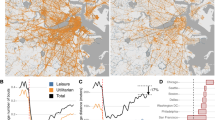
Effect of COVID-19 response policies on walking behavior in US cities

Mapping global variation in human mobility
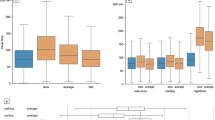
A travel time matrix data set for the Helsinki region 2023 that is sensitive to time, mode and interpersonal differences, and uses open data and novel open-source software
Background & summary.
The COVID-19 pandemic has spread across the world, infecting tens of millions and killing over one million people 1 . By March 2021, the United States (U.S.) had recorded the highest number of confirmed COVID-19 cases and COVID-19 related deaths in the world 1 . Since social distancing is one of the most effective measures in containing the spread of the infection 2 , several U.S. states issued various restrictions including stay at home orders. Moreover, numerous restaurants and bars closed for dine-in services, various recreation facilities were shut down, many offices and schools switched from meeting in-person to meeting online, and travel restrictions were imposed. These measures had a profound impact on how people in the U.S. went about their daily lives.
To understand the current and future impacts of the pandemic, we conducted a nationwide online survey. The goal of the survey is to capture attitudes and shifts in travel-related choices of people across the nation both during the pandemic and once COVID-19 is no longer a threat. The data are shared publicly in order to help government agencies and businesses prepare for the future. We are conducting additional survey waves with the same respondents to monitor how people’s choices evolve over the course of the pandemic and beyond.
An early version of the survey took place from April to June 2020, when the stay at home orders were in place in most parts of the country 3 , 4 ; this portion of the data collection is referenced as Wave 1 A . A slightly-modified larger-scale survey, Wave 1B ,was deployed between late June and October 2020. Subsequent survey waves are being conducted as the situation evolves. The collected data are released as they become available and necessary procedures for cleaning, documenting, and weighting the data are completed. This procedures for data processing are detailed in this paper. The present article focuses on data from the first wave of the survey.
In the months following the beginning of the spread of COVID-19, several efforts have been made to collect data related to COVID-19. In fact, many datasets have been compiled, specifically on COVID-19 testing 5 , medical imaging of COVID-19 cases 6 , the timeline of government interventions 7 , policy announcements 8 , implementation and relaxation of public health and social measures 9 , epidemiological data 10 , mobility-related data 11 , and out-of-home activity information 12 , to name a few. Researchers also turned to social media platforms, like Twitter and Instagram, to gather COVID-19-related data 13 , 14 , 15 , 16 . Furthermore, several surveys have been conducted to measure the impacts of the pandemic 17 , 18 , 19 , some of which are now released for public use 20 , 21 .
Our survey data are different from most others in several ways. First, it is comprehensive insofar as it includes data about a wide range of topics including commuting, daily travel, air travel, working from home, online learning, shopping, attitudes, risk perception, and socioeconomic and demographic details. Second, it captures detailed information about behaviors before and during the COVID-19 pandemic, as well as the choices that people expect to make when the COVID-19 virus is no longer a threat. Third, it was collected from respondents across the U.S., covering diverse socio-economic backgrounds, professions, education levels, and ages. Fourth, the survey is a true longitudinal panel survey, collecting data in multiple waves from the same individuals at regular intervals. Finally, the data are made publicly available to promote data-driven analysis and research.
The next section describes the data collection methodology, the questions included in the survey, the survey deployment process, and the participant recruitment strategy. Next, the data records section describes the data file types and metadata. Subsequently, the technical validation section explains the procedure for the survey data cleaning and weighting. Lastly, the final section provides additional notes for data users.
Ethical compliance
Our study protocol was approved by both Arizona State University (ASU) and University of Illinois at Chicago (UIC) Institutional Review Board offices. Participants were informed that their participation is voluntary, and that their responses are shared anonymously. An online informed consent was obtained from everyone who responded to the survey.
Survey questions
The data were collected through an extensive online survey with over 120 questions. The survey questions can be broadly divided into three categories: (1) retrospective questions focusing on the period before COVID-19, (2) questions about the period during COVID-19, and (3) prospective questions on respondent expectations for a future period in which COVID-19 is no longer a threat. The questions cover a wide variety of subjects including commuting habits, discretionary travel choices, work-related questions, study-related questions, shopping, dining, and so on – all before, during, and expected after the pandemic.
The survey questions can be classified into eight categories based on question subject type, namely: demographics, work, study, shopping and dining, transportation, and general attitudes. Table 1 describes each of these categories.
Survey recruitment
From April to mid-June 2020, initial Wave 1A responses were collected from a convenience sample via mailing lists, social media outreach, and mainstream media articles. A total of 1,110 responses were collected during this phase.
From late June onward, Wave 1B, the modified version of the survey, was deployed through survey invitations sent to a random email list purchased from a data marketing company. The list contained 350,000 email addresses belonging to people in 24 metropolitan areas across the U.S., as well as the state of Ohio (see Fig. 1 ). We purchased 100,000 additional email addresses of people randomly selected from across the country, including rural areas and excluding the areas covered by the first 350,000 emails. A total of 1,116 responses were received from the email list. Unfortunately, major email service providers quickly began marking our survey invitations as spam, while some smaller providers did not. While we took several steps to mitigate this issue, including changing the wording of the emails, changing the source of the emails (a uic.edu, asu.edu, or covidfuture.org email address), we were ultimately not able to fully solve this problem and saw a lower response rate from individuals with addresses from major email providers.
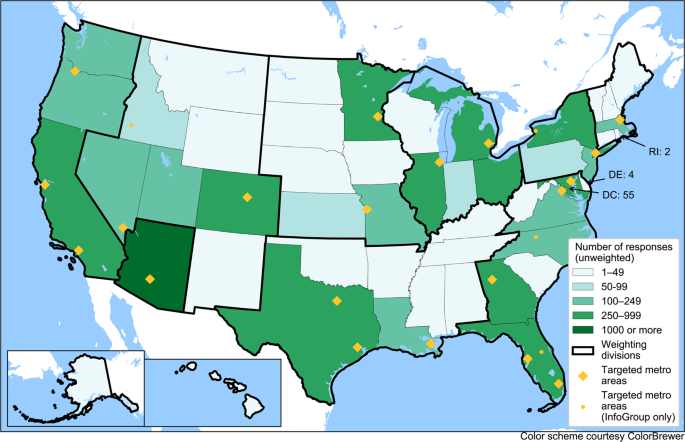
Distribution of survey respondents by the state of residence for survey dataset version 1.0. Alaska and Hawai’i are in the same weighting division as California, Oregon, and Washington.
Survey invitation emails were also sent to an additional list of approximately 39,000 email addresses from the Phoenix metropolitan area purchased for a previous survey effort 22 . This list yielded 782 responses. The survey invitation emails were sent using Amazon Web Services (AWS) and through the Qualtrics platform. Every 20 th respondent who was invited through the purchased email addresses received a $10 incentive as a gift card. Respondents also had the option to donate their survey incentive to a charity. Invitees received two reminders as part of efforts to maximize response rates.
An additional 5,250 responses to the Wave 1B survey were collected through a Qualtrics Online Panel. Qualtrics recruits these respondents from a variety of panels maintained by other firms and uses quota sampling to recruit respondents that are demographically representative of the nation. The Qualtrics quotas were set to collect information from 20 U.S. metropolitan areas, mostly consistent with the metropolitan areas sampled from the purchased email list, as well as the states of Ohio, Utah, North Carolina, upstate New York, and rural areas. In order to obtain samples that would represent the population in each of the selected geographies, quotas were imposed in the Qualtrics online panel subsample to guarantee representation based on income, age, race and ethnicity, and education. We requested all respondents to provide their email addresses in order to recontact them for subsequent survey waves. Since the Qualtrics respondents are professional survey takers, we designated most questions as mandatory, and we included attention check questions, which are shown to improve response quality 23 .
The distribution of responses by geography, as well as the targeted metropolitan areas, are shown in Fig. 1 . Figure 2 shows the distribution of responses by recruitment method, available in the “org” variable in the dataset. The geographical targets were chosen based on geographic and metropolitan area size diversity, as well as the state of the virus spread in May 2020.
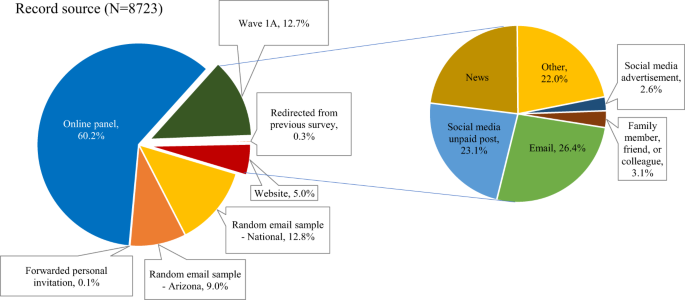
Distribution of Record by Source (from the survey dataset version 1.0).
Figure 1 shows the distribution of survey respondents across the U.S. (50 states and the District of Columbia). Following our recruitment strategy, a greater number of responses come from larger and more urban states. Arizona is overrepresented due to the oversample of Arizona respondents in the email-based deployment. The respondents from the initial Wave 1A sample are also more likely to hail from Arizona as the Arizona State University survey team’s network is heavily Arizona-based. When the data are weighted, any geographic discrepancies at the census division level are controlled and overrepresentation of Arizona is controlled/corrected separately.
Additional survey waves
To monitor how people’s attitudes and behaviors evolve, survey respondents are contacted again with at least two shorter follow-up surveys, approximately four months apart in spring and fall 2021.
Data Records
The survey dataset 24 can be accessed from the ASU Dataverse at: https://doi.org/10.48349/ASU/QO7BTC . The dataset is available in CSV (comma-separated value) format. Since the data will be updated periodically, the data are versioned—in this article, results from the survey dataset version 1.0 are reported. The dataverse also contains the database codebook containing the metadata and explaining the variables. The codebook contains a changelog for each new version.
The respondents to Waves 1A and 1B received similar but not identical surveys. We have merged the responses to these two versions of the survey into the final dataset wherever possible. For some variables, the questions were identical, whereas for other variables, harmonization of similar responses was required. In the dataset, variables ending in ‘_harm’ are harmonized between the two datasets, variables ending in ‘_w1a’ are available only for Wave 1A respondents, variables ending in ‘_w1b’ are available only for respondents from our Qualtrics Online Panel, purchased email lists, and anyone who found the survey via the COVIDFuture web site or email lists after June 19, 2020 (start date of Wave 1B). Variables with no suffix were asked the same way between the two surveys, and no harmonization was necessary. We also provide a file containing only Wave 1B responses and variables, which simplifies analysis of the Wave 1B data.
Technical Validation
Data cleaning.
To monitor respondents’ attention to survey questions in the Qualtrics online panel, attention check questions were included. Respondents were allowed to miss one attention check and be given an opportunity to answer that section again. If they missed an attention check twice, or both attention checks once, their survey was terminated.
We additionally undertook several quality checks to help ensure that the collected data were valid. We removed any respondents who reported that they shop for groceries both in-store and online every day, or expect to after the pandemic, as these are likely to be invalid responses. We also removed respondents who reported strongly agreeing or strongly disagreeing with all COVID-related attitudes, as some of these were worded positively and some negatively. Several additional quality checks were undertaken in the Qualtrics Online Panel as part of Qualtrics’ data cleaning process, including a check for people finishing the survey too quickly.
Respondents that did not report a state of residence, reported living outside the 50 states and the District of Columbia, or did not provide answers to all of the control variables used in the data weighting process described in the next section were removed from the data. Due to this restriction, 558 records with missing control variable information, 59 records with missing home location, and one response from Puerto Rico were not included in the final dataset encompassing responses received through October 14, 2020. Further steps in data preparation will include imputation of missing data, which will allow for some of these omitted records to be recovered in the next version of the dataset. Among the respondents who were not included in the dataset due to missing control variable information, there are 34 respondents who declared their gender as Other; these respondents could not be included because the Census offers no control marginals to weight these records. Further data weighting procedures will attempt to incorporate non-binary gendered individuals on the dataset. Due to the data cleaning and filtering process applied to responses obtained through October 14, 2020, a total of 618 records were not included in the published dataset.
Data weighting
Because the raw data are not fully representative of the U.S. population, weights were calculated using the following control variables: age, education, gender, Hispanic status, household income, presence of children, and number of household vehicles. The weighting procedure accounts for the true population characteristics at the person level. Household-level variables (i.e., income, presence of children, and number of vehicles) were controlled at the person level as well. For example, the marginal distribution used for presence of children refers to the share of adults aged 18 years and older living in household with children, instead of the share of households that have children as it is usually represented. Those marginal distributions were computed using data from the Integrated Public Use Microdata Sample and the American Community Survey (ACS) 2018 1-year data 25 using the sample 18 and older in each of the weighting region boundaries. A noteworthy consequence of this approach is that adjusted household weights are necessary to evaluate household-level characteristics since individuals from larger households are more likely to be represented in the survey (given there are more individuals in these households), and thus have a higher probability of being selected. Weights for household-level analysis can be computed by dividing the person-level weight (provided in the data) by the number of adults in the household.
The national sample was divided into nine regions based on the reported home state (Table 2 ). Each region’s sample was then weighted to match the distributions observed in ACS 2018 1-year estimates 25 , meaning that the survey is demographically representative at the level of each region as well as the entire U.S. The unweighted and weighted survey results are shown in Table 3 ; the weighted results closely replicate population distributions, with inevitable minor deviations on variables that were not controlled in the weighting process.
Weights were calculated using iterative proportional fitting (IPF) procedures embedded within the synthetic population generator PopGen2.0 26 , 27 , 28 . Univariate marginal control distributions were derived from the Integrated Public Use Microdata Sample, American Community Survey (ACS) 2018 1-year data 25 .
Usage Notes
Since the survey will be followed by at least two follow-up survey waves, the database will be updated periodically after the data for each wave is collected, cleaned, and weighted. Each version of the data will be uploaded to the ASU Dataverse and assigned a new DOI number, and all previous versions will remain available to promote reproducibility.
The weights were developed to produce a sample that is representative of the U.S. population, as well as representative of nine divisions within the U.S.: eight census regions (with East and West South Central combined due to small samples in these regions), and a separate category for Arizona due to its large number of respondents. The weights are not guaranteed to produce a representative sample for other (smaller) geographies. When evaluating subsamples at a finer geography (e.g., state or metropolitan area), data users should compare marginal distributions of key demographic variables with the census, and re-weight the data if needed to be representative of the area being analyzed.
Some questions differ between Waves 1A and 1B. Therefore, we have weighted the dataset twice: once including all respondents (Waves 1A and 1B), and once excluding respondents to the Wave 1A sample. Data users should use the Wave 1B weights whenever using variables that are not present in the convenience sample. Since Wave 1A data deviates significantly in terms of population representativeness 4 , there are no weights for questions asked only of Wave 1A respondents. In the file with only Wave 1B responses, only Wave 1B weights are presented.
This unique dataset provides insights on attitudes and behaviors not just before and during pandemic, but also on what might be expected after the pandemic. Possible use cases include modeling of during-pandemic and longer-term changes in mode use, air travel, transit ridership, work from home, and traffic congestion (especially for peak period traffic planning). Published uses of this dataset are documented in Capasso da Silva et al . 29 , Chauhan et al . 30 , Mirtich et al . 31 , and Salon et al . 32 .
Code availability
No codes were developed for this research.
COVID-19 Map. Johns Hopkins Coronavirus Resource Center https://coronavirus.jhu.edu/map.html (2020).
CDC. Coronavirus Disease 2019 (COVID-19). Centers for Disease Control and Prevention https://www.cdc.gov/coronavirus/2019-ncov/prevent-getting-sick/social-distancing.html (2020).
Shamshiripour, A., Rahimi, E., Shabanpour, R. & Mohammadian, A. K. How is COVID-19 reshaping activity-travel behavior? Evidence from a comprehensive survey in Chicago. Transp. Res. Interdiscip. Perspect. 7 , 100216 (2020).
PubMed PubMed Central Google Scholar
Conway, M. W., Salon, D., da Silva, D. C. & Mirtich, L. How will the COVID-19 pandemic affect the future of urban life? Early evidence from highly-educated respondents in the United States. Urban Sci. 4 , 50 (2020).
Article Google Scholar
Hasell, J. et al . A cross-country database of COVID-19 testing. Sci. Data 7 , 1–7 (2020).
Kalkreuth, R. & Kaufmann, P. COVID-19: a survey on public medical imaging data resources. ArXiv Prepr. ArXiv200404569 (2020).
Desvars-Larrive, A. et al . A structured open dataset of government interventions in response to COVID-19. medRxiv (2020).
Cheng, C., Barceló, J., Hartnett, A. S., Kubinec, R. & Messerschmidt, L. Covid-19 government response event dataset (coronanet v. 1.0). Nat. Hum. Behav. 4 , 756–768 (2020).
Zheng, Q. et al . HIT-COVID, a global database tracking public health interventions to COVID-19. Sci. Data 7 , 1–8 (2020).
Xu, B. et al . Epidemiological data from the COVID-19 outbreak, real-time case information. Sci. Data 7 , 1–6 (2020).
Pepe, E. et al . COVID-19 outbreak response, a dataset to assess mobility changes in Italy following national lockdown. Sci. Data 7 , 1–7 (2020).
Killeen, B. D. et al . A County-level dataset for informing the United States’ response to COVID-19. ArXiv Prepr. ArXiv200400756 (2020).
Chen, E., Lerman, K. & Ferrara, E. Tracking social media discourse about the COVID-19 pandemic: Development of a public coronavirus Twitter data set. JMIR Public Health Surveill. 6 , e19273 (2020).
Zarei, K., Farahbakhsh, R., Crespi, N. & Tyson, G. A first Instagram dataset on COVID-19. ArXiv Prepr. ArXiv200412226 (2020).
Alqurashi, S., Alhindi, A. & Alanazi, E. Large arabic twitter dataset on covid-19. ArXiv Prepr. ArXiv200404315 (2020).
Lopez, C. E., Vasu, M. & Gallemore, C. Understanding the perception of COVID-19 policies by mining a multilanguage Twitter dataset. ArXiv Prepr. ArXiv200310359 (2020).
Gensler. US Work from home survey 2020. Gensler-US-Work-From-Home-Survey-2020-Briefing-1.pdf (2020).
Kleinberg, B., van der Vegt, I. & Mozes, M. Measuring emotions in the covid-19 real world worry dataset. ArXiv Prepr. ArXiv200404225 (2020).
Grashuis, J., Skevas, T. & Segovia, M. S. Grocery shopping preferences during the COVID-19 pandemic. Sustainability 12 , 5369 (2020).
Article CAS Google Scholar
Shuja, J., Alanazi, E., Alasmary, W. & Alashaikh, A. Covid-19 open source data sets: A comprehensive survey. Appl. Intell . 1–30 (2020).
Trung, T. et al . Dataset of Vietnamese student’s learning habits during COVID-19. Data Brief 105682 (2020).
Khoeini, S. et al . Attitudes Towards Emerging Mobility Options and Technologies – Phase 2: Pilot and Full Survey Deployment . https://tomnet-utc.engineering.asu.edu/wp-content/uploads/2020/11/TOMNET-Year-2-Project-Report-All-Universities_-Attitudes-Towards-Mobility-Options-Technologies.pdf (2019).
Shamon, H. & Berning, C. Attention check items and instructions in online surveys: Boon or bane for data quality? Surv. Res. Methods Forthcom . (2019).
Salon, D. et al . COVID Future Wave 1 Survey Data v1.0.0. ASU Library Research Data Repository https://doi.org/10.48349/ASU/QO7BTC (2020).
Ruggles, S. et al . IPUMS USA: Version 10.0 Minneapolis, MN: IPUMS https://doi.org/10.18128/D010.V10.0 (2020).
PopGen. MARG - Mobility Analytics Research Group https://www.mobilityanalytics.org/popgen.html (2020).
Ye, X., Konduri, K., Pendyala, R. M., Sana, B. & Waddell, P. A methodology to match distributions of both household and person attributes in the generation of synthetic populations. In 88th Annual Meeting of the Transportation Research Board, Washington, DC (2009).
Konduri, K. C., You, D., Garikapati, V. M. & Pendyala, R. M. Enhanced synthetic population generator that accommodates control variables at multiple geographic resolutions. Transp. Res. Rec. 2563 , 40–50 (2016).
Capasso da Silva, D. et al . How are attitudes toward COVID-19 associated with traveler behavior during the pandemic? Findings https://doi.org/10.32866/001c.24389 (2021).
Chauhan, R. S. et al . COVID-19 related attitudes and risk perceptions across urban, rural, and suburban areas in the United States. Findings https://doi.org/10.32866/001c.23714 (2021).
Mirtich, L. et al . How stable are transport-related attitudes over time? Findings https://doi.org/10.32866/001c.24556 (2021).
Salon, D. et al . The potential stickiness of pandemic-induced behavior changes in the United States. Proceedings of the National Academy of Sciences 118 (27), e2106499118, https://doi.org/10.1073/pnas.2106499118 (2021).
Download references
Acknowledgements
This research was supported in part by the National Science Foundation (NSF) RAPID program under grants no. 2030156 and 2029962 and by the Center for Teaching Old Models New Tricks (TOMNET), a University Transportation Center sponsored by the U.S. Department of Transportation through grant no. 69A3551747116, as well as by the Knowledge Exchange for Resilience at Arizona State University. This COVID-19 Working Group effort was also supported by the NSF-funded Social Science Extreme Events Research (SSEER) network and the CONVERGE facility at the Natural Hazards Center at the University of Colorado Boulder (NSF Award #1841338) and the NSF CAREER award under grant no. 155173. Any opinions, findings, and conclusions or recommendations expressed in this material are those of the authors and do not necessarily reflect the views of the funders.
Author information
Authors and affiliations.
Department of Civil, Materials, and Environmental Engineering, University of Illinois at Chicago, Chicago, IL, USA
Rishabh Singh Chauhan, Ali Shamshiripour, Ehsan Rahimi, Abolfazl (Kouros) Mohammadian & Sybil Derrible
School of Geographical Sciences and Urban Planning, Arizona State University, Tempe, AZ, USA
Matthew Wigginton Bhagat-Conway & Deborah Salon
School of Sustainable Engineering and the Built Environment, Arizona State University, Tempe, AZ, USA
Denise Capasso da Silva, Sara Khoeini & Ram Pendyala
You can also search for this author in PubMed Google Scholar
Contributions
R.P., A.M., S.D., D.S. and S.K. planned the project. D.S., M.C., D.C.S., R.C., E.R. and A.M. prepared the survey questions. M.C., D.C.S. and D.S. designed the survey flow logic. R.C., D.C.S., M.C., D.S. and S.D. deployed the survey. M.C. and D.C.S. performed data cleaning and survey data analysis. D.C.S. weighted the dataset. M.C. and D.S. worked on sending out the incentives to the selected respondents. R.C. prepared the first draft. All the authors made significant contributions to manuscript editing and approving the final version of the manuscript.
Corresponding author
Correspondence to Rishabh Singh Chauhan .
Ethics declarations
Competing interests.
The authors declare no competing interests.
Additional information
Publisher’s note Springer Nature remains neutral with regard to jurisdictional claims in published maps and institutional affiliations.
Rights and permissions
Open Access This article is licensed under a Creative Commons Attribution 4.0 International License, which permits use, sharing, adaptation, distribution and reproduction in any medium or format, as long as you give appropriate credit to the original author(s) and the source, provide a link to the Creative Commons license, and indicate if changes were made. The images or other third party material in this article are included in the article’s Creative Commons license, unless indicated otherwise in a credit line to the material. If material is not included in the article’s Creative Commons license and your intended use is not permitted by statutory regulation or exceeds the permitted use, you will need to obtain permission directly from the copyright holder. To view a copy of this license, visit http://creativecommons.org/licenses/by/4.0/ .
The Creative Commons Public Domain Dedication waiver http://creativecommons.org/publicdomain/zero/1.0/ applies to the metadata files associated with this article.
Reprints and permissions
About this article
Cite this article.
Chauhan, R.S., Bhagat-Conway, M.W., Capasso da Silva, D. et al. A database of travel-related behaviors and attitudes before, during, and after COVID-19 in the United States. Sci Data 8 , 245 (2021). https://doi.org/10.1038/s41597-021-01020-8
Download citation
Received : 14 December 2020
Accepted : 29 July 2021
Published : 23 September 2021
DOI : https://doi.org/10.1038/s41597-021-01020-8
Share this article
Anyone you share the following link with will be able to read this content:
Sorry, a shareable link is not currently available for this article.
Provided by the Springer Nature SharedIt content-sharing initiative
This article is cited by
Covid future panel survey: a unique public dataset documenting how u.s. residents’ travel-related choices changed during the covid-19 pandemic.
- R. S. Chauhan
- M. Bhagat-Conway
Transportation (2024)
The interaction between the recent evolution of working from home and online shopping
- Motahare Mohammadi
- Amir Davatgari
- Deborah Salon
Response willingness in consecutive travel surveys: an investigation based on the National Household Travel Survey using a sample selection model
- F. Atiyya Shaw
- Kari E. Watkins
Transportation (2023)
Tracking the state and behavior of people in response to COVID-19 through the fusion of multiple longitudinal data streams
- Mohamed Amine Bouzaghrane
- Hassan Obeid
- Joan Walker
Quick links
- Explore articles by subject
- Guide to authors
- Editorial policies
Sign up for the Nature Briefing newsletter — what matters in science, free to your inbox daily.
UN Tourism | Bringing the world closer
The first global dashboard for tourism insights.
- UN Tourism Tourism Dashboard
- Language Services
- Publications
share this content
- Share this article on facebook
- Share this article on twitter
- Share this article on linkedin
UN Tourism Data Dashboard
The UN Tourism Data Dashboard – provides statistics and insights on key indicators for inbound and outbound tourism at the global, regional and national levels. Data covers tourist arrivals, tourism share of exports and contribution to GDP, source markets, seasonality and accommodation (data on number of rooms, guest and nights)
Two special modules present data on the impact of COVID 19 on tourism as well as a Policy Tracker on Measures to Support Tourism
The UN Tourism/IATA Destination Tracker
Un tourism tracker.
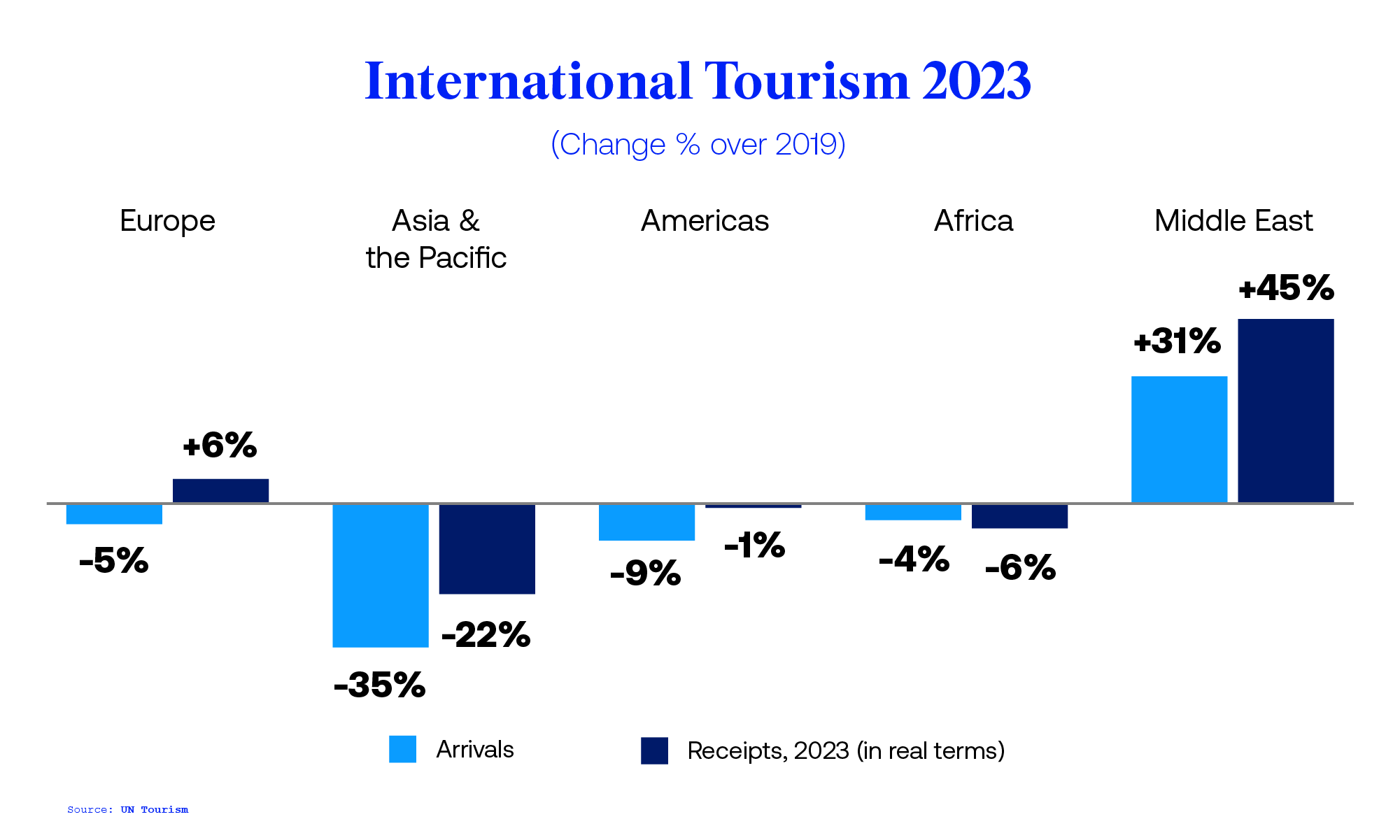
- International tourist arrivals and receipts and export revenues
- International tourism expenditure and departures
- Seasonality
- Tourism Flows
- Accommodation
- Tourism GDP and Employment
- Domestic Tourism
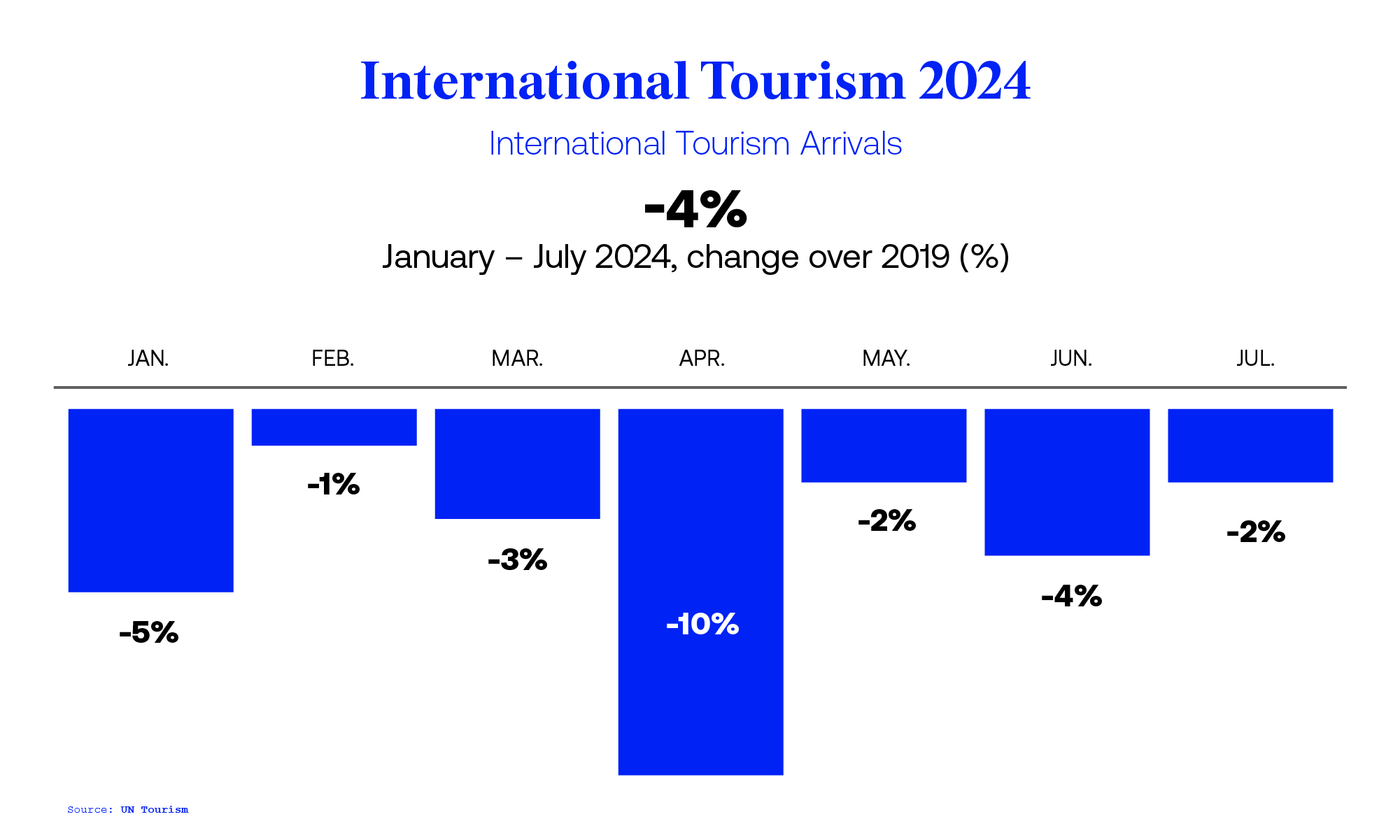
International Tourism and COVID-19
- The pandemic generated a loss of 2.6 billion international arrivals in 2020, 2021 and 2022 combined
- Export revenues from international tourism dropped 62% in 2020 and 59% in 2021, versus 2019 (real terms) and then rebounded in 2022, remaining 34% below pre-pandemic levels.
- The total loss in export revenues from tourism amounts to USD 2.6 trillion for that three-year period.
- International tourist arrivals reached 89% of pre-pandemic levels in 2023 and 97% in Q1 2024
COVID-19: Measures to Support Travel and Tourism
Home › Travel Hospitality › A Guide to Data Analytics in the Travel Industry
A Guide to Data Analytics in the Travel Industry
Written by: Medha Banerjee
Introduction to data analytics in travel industry
Welcome to “Navigating the Data Highway: A Comprehensive Guide to Data Analytics in the Travel Industry,” where we unravel the transformative power of data in shaping our journeys. In today’s dynamic travel landscape, stakeholders across the industry are realizing that knowledge truly is power, and data serves as the fuel for informed decision-making.
In this exploration, we dive into how Big Data and advanced analytics are revolutionizing the way travel agencies and stakeholders operate. Every click, swipe, and booking leaves behind a digital footprint, and it’s through harnessing this data that the industry is experiencing unprecedented growth and efficiency.
From personalized experiences tailored to individual traveler preferences to predictive insights driving business growth, data analytics serves as the compass guiding the industry forward. Our journey begins with a deep dive into how Big Data , Customer Experience, Business Growth, Predictive Insights, Booking Trends, Traveler Preferences, Marketing Strategies, Travel Demand Forecasting, Personalized Services, Price Optimization, Customer Satisfaction, Data governance strategy, Data-driven business decisions, Data-driven travel experiences and Data-driven revenue optimization, optimized pricing strategies and data-driven marketing initiatives are maximizing marketing ROI and meeting traveler demands.
We’ll uncover how data-driven customer experiences are not just a luxury but a necessity in today’s competitive landscape. Through AI and ML algorithms, travel agencies can forecast travel demand, optimize pricing, and offer personalized services that enhance customer satisfaction and loyalty.
But with great power comes great responsibility. Data governance policies and strategies are essential to ensure the ethical and secure handling of personally identifiable information (PII). By implementing robust data governance frameworks and leveraging data intelligence platforms, stakeholders can make informed, data-driven decisions while safeguarding sensitive information.
Join us on this journey as we unveil the secrets and strategies that are reshaping the future of travel. Together, let’s navigate the data highway toward unparalleled operational efficiency, personalized experiences, and sustainable growth in the travel industry.
Book a demo to experience the meaningful insights we derive from data through our data analytics tools and platform capabilities. Schedule a demo today!
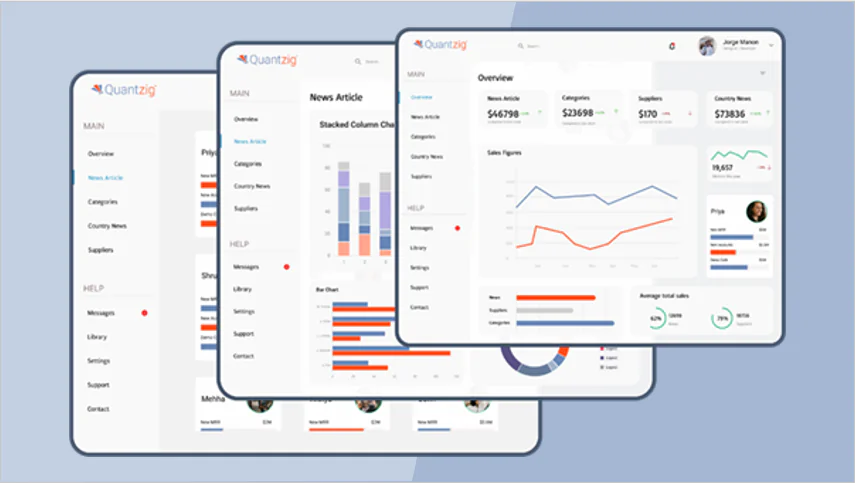
Importance of Data Analytics in the Travel Industry:
The travel industry can leverage the power of enhanced Revenue Operations (RevOps) by delving into crucial factors like demand dynamics, pricing strategies, and competitor activity. In an environment characterized by fluctuating demand and dynamic market conditions, data-driven insights are paramount. By analyzing data on customer preferences, market trends, and historical booking patterns, businesses can make quicker, more informed decisions on pricing and promotional strategies.
RevOps enables companies to adapt to real-time changes in demand, fine-tune pricing models, and implement dynamic promotions. This agility allows travel businesses to maximize revenue while staying competitive in a fast-paced industry. Furthermore, the ability to respond swiftly to market shifts by Stakeholders, Travel Agencies, Big Data, Customer Experience, Business Growth, Personalized Experiences, Predictive Insights, Optimized Pricing, Marketing ROI, Booking Trends, Traveler Preferences, Marketing Strategies, Travel Demand Forecasting, Personalized Services, Price Optimization, Customer Satisfaction enhances profitability, customer satisfaction, and overall operational efficiency, making data-driven RevOps a vital asset for success in the travel sector .
Incorporating AI and ML technologies, along with a robust data governance strategy and policies safeguarding PII, travel businesses can create a robust data intelligence platform. This platform empowers them to make data-driven business decisions, leading to enhanced operational efficiency and revenue optimization. Moreover, leveraging data-driven insights facilitates the creation of personalized, data-driven travel experiences, enriching customer satisfaction and loyalty. By embracing data-driven revenue optimization, Data governance strategy, Data intelligence platform and ata-driven customer experiences, travel companies can thrive in a competitive landscape while ensuring adherence to stringent data governance policies.
Challenges faced while implementing Data Analytics in the Travel Industry:
The success of the travel industry is contingent on a holistic approach that prioritizes excellence before, during, and after the customer’s experience. To achieve this, the industry is increasingly recognizing the significance of Revenue Operations (RevOps), Stakeholders, Travel Agencies, Big Data, Customer Experience, Business Growth, Personalized Experiences, Predictive Insights, Optimized Pricing, Marketing ROI, Booking Trends, Traveler Preferences, Marketing Strategies, Travel Demand Forecasting, Personalized Services, Price Optimization, Customer Satisfaction in orchestrating seamless and efficient journeys.
Efficiently managing the different stages and constructing a high-performance RevOps framework is a crucial strategic endeavor for ensuring continual expansion. This endeavor necessitates a systematic overhaul, involving a fundamental change in operational efficiency. Central to this transformation is the implementation of advanced technologies such as AI and ML, alongside the establishment of robust data governance strategies and policies. Leveraging a sophisticated data intelligence platform, PII (personally identifiable information), Data governance policies, Data intelligence platform, Data-driven travel experiences, Data-driven revenue optimization and Data-driven customer experiences becomes imperative for making informed, data-driven business decisions and optimizing revenue streams. Moreover, it paves the way for delivering personalized travel experiences driven by data insights, thus enhancing customer satisfaction and overall business performance.
Excellence before the experience involves precise market analysis, pricing strategies, and demand forecasting to attract the right audience. During the experience, operations, service quality, and customer satisfaction are paramount. After the experience, post-trip engagement, loyalty-building, and data-driven insights play a pivotal role.
RevOps serves as the linchpin connecting these phases, optimizing processes, pricing, and promotions, ultimately enhancing the overall guest journey in the travel industry. Programmatic transformation empowers the industry to adapt, innovate, and stay competitive in a rapidly evolving landscape, ensuring that travelers receive excellence at every stage of their journey. By integrating data analytics into decision-making processes, RevOps enables vendors, partners, and other stakeholders to understand the dynamics of the travel sector and the industries better. This insight allows for more informed decisions regarding pricing strategies, promotional campaigns, and resource allocation, ultimately leading to increased traveler revenue and improved customer experiences. Furthermore, it equips industry players with the necessary tools to navigate the complexities of the travel industry and capitalize on emerging opportunities.
Experience the advantages firsthand by testing a customized complimentary pilot designed to address your specific data analytics requirements. Pilot studies are non-committal in nature.
Benefits of implementing Data Analytics in the Travel Industry:
Our RevOps Solutions suite represents a transformative approach to handling data complexities within the travel industry. From the cockpit of your operations to advanced simulators, our suite is meticulously designed to streamline your data ecosystem. We enable actionable reporting and equip decision-makers with advanced analytics capabilities that empower them to navigate the dynamic landscape of the travel sector. With features such as dynamic pricing and proactive strategies to address disruptions, our suite ensures that your company stays ahead of the curve. Additionally, we prioritize customer support to enhance satisfaction and foster loyalty. By leveraging Customer Support, Satisfactio, Companies, Oceans of Data insights from oceans of data, we help you optimize demand, refine services, and fine-tune operations to gain a competitive edge in the market.
Central to our approach is the deployment of highly efficient analytics engines that seamlessly integrate with your data infrastructure. These engines not only process data but also provide predictive and simulation capabilities, delivering insights in real-time or near-real time. This means that decision-makers have access to up-to-the-minute data, allowing them to make informed, data-driven decisions that can significantly impact revenue, customer satisfaction, and operational efficiency. In an industry as fast-paced and dynamic as travel, having the ability to make strategic decisions based on the latest data is a game-changer, and our RevOps Solutions suite makes it possible.
Customers benefit from these capabilities by receiving more personalized experiences, while businesses can identify trends and patterns in customer behavior to tailor their offerings accordingly. However, leveraging this data comes with its own set of challenges, including ensuring the sustainability of data practices and navigating the complex travel landscape.
Yet, amidst these challenges lie significant opportunities for improvement and innovation. By harnessing the power of data intelligence and embracing real-time insights, Table of Contents, Benefits, Types of Data, Sustainability Efforts, Improvement businesses can stay ahead of the curve and capitalize on emerging trends. Our suite of RevOps Solutions is designed to support these efforts, enabling organizations to adapt quickly to changing market conditions and drive sustainable growth.
Get started with your complimentary trial today and delve into our platform without any obligations. Explore our wide range of customized, data analytics solutions built across the analytical maturity levels.
Success Story:
“Transforming Travel Excellence: How Quantzig’s Data Analytics Guide Supercharged Client Success”
Client details:
The Client is a Leading Hotel Chain based out of the US that operates multi-brand hotels across the country.
Challenges faced by the client:
The objective of our client was to find an integrated solution that could effectively address performance measurement, streamline operational processes, and enhance decision-making support. The primary goal was to establish a cohesive framework that enabled comprehensive data analysis, allowing the organization to gauge performance, identify areas for improvement, and make data-driven decisions. By implementing this connected solution, the company aimed to optimize its operations, increase efficiency, and ensure that decision-makers had access to real-time, actionable insights to drive strategic planning and growth.
To achieve this, the solution needed to encompass a wide range of data types, including Social Media Data, Geospatial Data, and External Data. Data Integration was crucial to consolidate these diverse data sources and manage the Data Volume effectively. Furthermore, the solution required capabilities for Real-time Data Processing to enable timely decision-making.
Once the data was collected and processed, Data Interpretation and data volume became essential to extract meaningful insights. However, it was equally important to ensure the Ethical Use of Data and Regulatory Compliance throughout the process, especially considering sensitive data such as PII.
Additionally, the integration of Mobile Roaming Data, Bluetooth Data, and Mobile Browser Data could provide valuable insights into customer behavior and preferences. However, this integration needed to be handled carefully to maintain Ethical Standards and comply with Regulatory Requirements.
Moreover, the implementation of such a solution would require effective Change Management to ensure smooth adoption and utilization across the organization. This would involve training employees on the new tools and processes and fostering a culture of data-driven decision-making at all levels of the organization. Ensuring data trustworthiness is paramount to mitigate risks such as data breaches and data privacy violations. By becoming a data-driven organization, businesses can harness data-driven strategies and data-driven insights to drive data-driven decisions and data-driven marketing initiatives, enabling the creation of targeted data-driven marketing segments.
Solutions offered by Quantzig:
Our RevOps solution is a pioneering system that seamlessly integrates performance data across the entire customer journey, encompassing the stages before, during, and after the trip. This holistic approach offers a comprehensive understanding of the entire value chain. To enhance decision-making, our solution provides a cohort of dashboards, each tailored to a specific stage of the customer journey. These dashboards act as strategic command centers, offering real-time insights and in-depth analytics.
A key feature is our root cause analysis components, which are embedded within the dashboards. These components excel at identifying variances in performance metrics and swiftly provide remediation recommendations directly within the dashboard interface. This dynamic functionality empowers businesses to not only track their key performance indicators but also proactively address issues, optimize processes, and enhance the customer experience throughout the journey.
In a rapidly evolving industry, our RevOps solution acts as a lighthouse, guiding businesses towards data-driven, performance-boosting strategies and decision-making, ultimately driving growth and excellence.
Impact delivered:
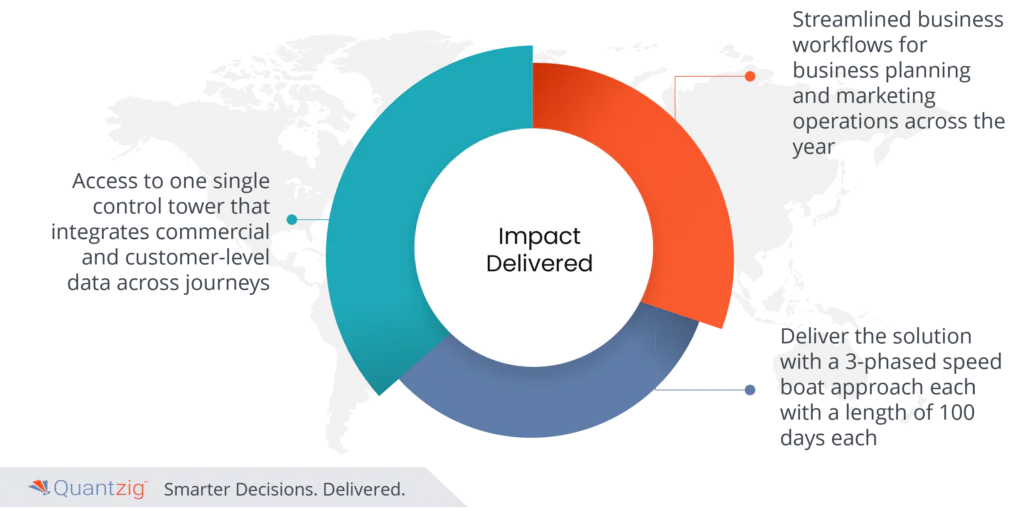
The client now has access to one single control tower that integrates both commercial and customer-level data across journeys, facilitated by a robust data governance framework. Quantzig was able to deliver the solution with a 3-phased speed boat approach each with a length of 100 days each. This integration eliminates data silos and ensures data security, promoting a data culture of transparency and accountability. Furthermore, it addresses data access management and data privacy, adhering to stringent data ethics standards. Additionally, it mitigates issues such as data duplication and enhances data quality through the implementation of a comprehensive data catalog and data management protocols. Leveraging tools like Google Analytics aids in data discovery and enables informed decision-making based on accurate insights.
In the ever-evolving realm of travel, data analytics emerges as the guiding compass, transforming the industry in unprecedented ways. As we conclude our guide to Data Analytics in the Travel Industry, we’ve unveiled the immense potential of data-driven insights in optimizing every aspect of the traveler’s journey. From personalized itineraries to responsive pricing strategies and enhanced customer experiences, data analytics has become the heartbeat of a vibrant and adaptive sector. It empowers decision-makers with the tools they need to navigate the dynamic landscape of travel, ultimately reshaping the way we explore the world.
In this data-driven paradigm, information sources such as Booking Data, Customer Reviews, Market Trends, and Social Media Interactions serve as invaluable assets, providing rich insights into traveler preferences and behaviors. Furthermore, real-time data streams such as Real-time Flight Data and Accommodation Data enable agile decision-making and timely adjustments to meet evolving demands.
The integration of Risk Management and Strategic Planning into data analytics frameworks enhances operational resilience and foresight, mitigating potential disruptions and optimizing resource allocation. Moreover, understanding various Data Types, including Personal Information, Travel History, Transaction Data, and Customer Feedback, allows for tailored experiences that resonate with individual preferences and needs.
By harnessing Behavioral Data and Loyalty Program Data, travel companies can foster lasting relationships with customers, driving loyalty and repeat business. Ultimately, data analytics empowers the industry to deliver on its promise of excellence, efficiency, and seamless discovery, ensuring that travelers embark on journeys defined by unparalleled experiences and enduring memories.
How is data analytics used in travel industry?
Data analytics is used in the travel industry to optimize pricing strategies, forecast demand, personalize marketing efforts, improve customer service, and enhance operational efficiency.
What types of data are analyzed in the travel industry?
In the travel industry, various types of data are analyzed, including booking data, customer demographics, travel preferences, website interactions, social media sentiments, competitive pricing data, and historical travel patterns.
What tools and technologies are used in data analytics for travel companies?
Travel companies use a range of tools and technologies for data analytics, including data visualization tools (such as Tableau or Power BI), predictive analytics software (like SAS or IBM SPSS), big data platforms (such as Hadoop or Spark), customer relationship management (CRM) systems, and machine learning algorithms.
How does data analytics benefit travelers?
Data analytics benefits travelers by enabling personalized recommendations, better travel planning assistance, real-time updates on flight and accommodation availability, improved customer service, and potentially lower prices through dynamic pricing models.
Recent Posts

Strategies for Achieving Success in the Implementation of Customer Analytics 3.0 Within an Organization

How BI Data Visualization Helps Organizations in Improving Business Performance

How Shopper Insights and Omni-Channel Targeting can create value for Retailers?
Privacy overview.
US Travel Header Utility Menu
- Future of Travel Mobility
- Travel Action Network
- Commission on Seamless & Secure Travel
- Travel Works
- Journey to Clean
Header Utility Social Links
- Follow us on FOLLOW US
- Follow us on Twitter
- Follow us on LinkedIn
- Follow us on Instagram
- Follow us on Facebook
User account menu
The u.s. travel insights dashboard.
INTERACTIVE TRAVEL DATA July 31, 2024
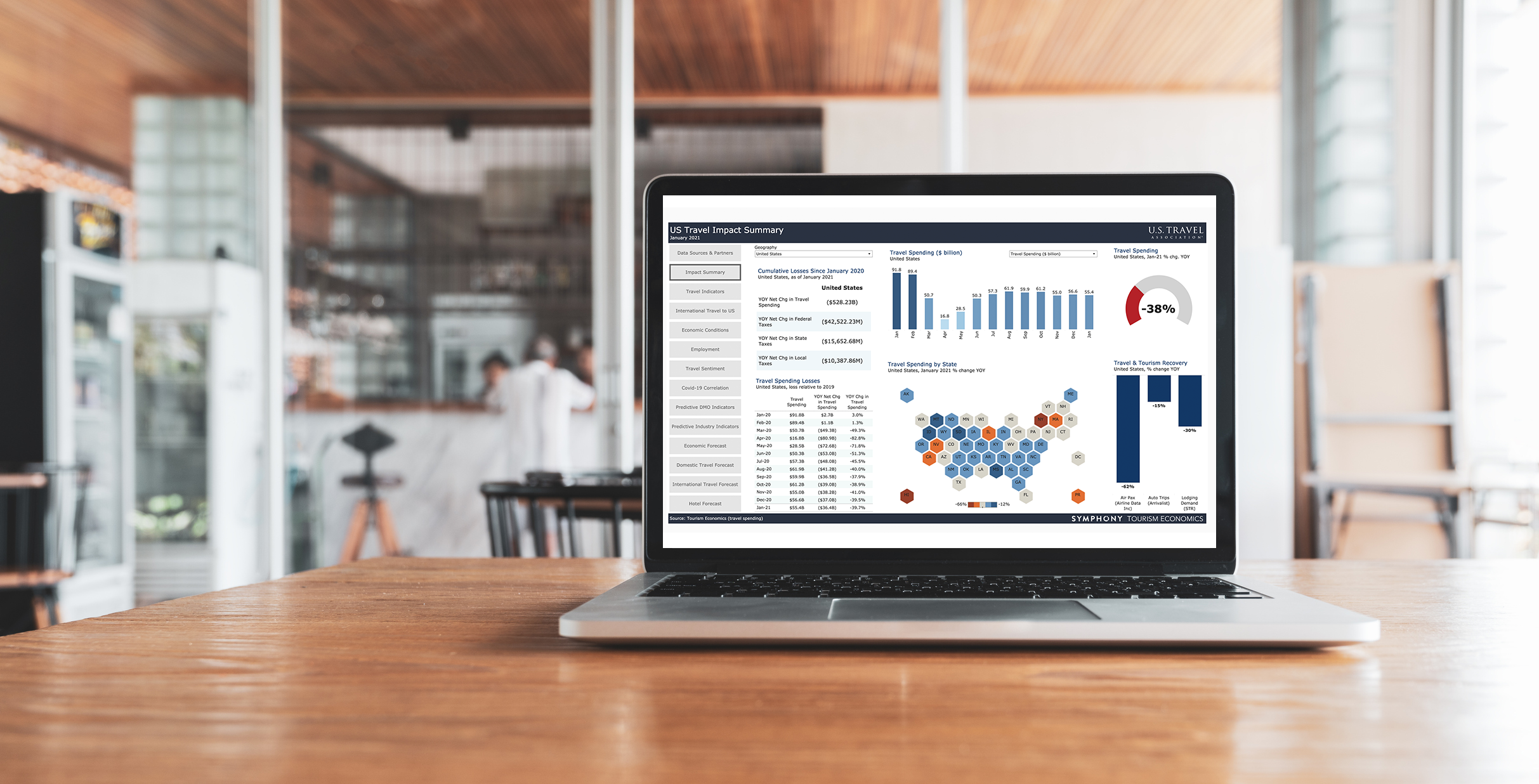
U.S. Travel members have access to the exclusive U.S. Travel Insights Dashboard, the most comprehensive and centralized source for high-frequency intelligence on the U.S. travel industry and the broader economy. The platform, powered by Tourism Economics, is supported by approximately 20 data partners and tracks industry performance, travel volumes and predictive travel indicators to provide members with a detailed, interactive view of travel's recovery and performance.
The dashboard is updated on the last week of each month. View key highlights and the latest summary in the Monthly Travel Data Report . Please note that the “Travel Indicators by State” tab has been revised and no longer includes state-by-state monthly travel spending data. It will now include trend data for lodging demand, leisure and hospitality jobs, and air passengers on a state-by-state level.
Supporting Data Providers
- Future Partners
- Longwoods International
- National Park Service
- Northstar Meetings Group
- U.S. Department of Commerce
- Airline Data Inc.
- National Travel and Tourism Office
- Oxford Economics
- Tourism Economics
- TravelClick, an Amadeus Company
- U.S. Bureau of Labor Statistics
LOG IN TO VIEW DASHBOARD
Member Login Required
Note: Any employee of a U.S. Travel member organization is eligible for access to this platform. Please contact [email protected] or 202.408.8422 if you have questions or need assistance logging in.
- Duty of Care
- Program Compliance
- Traxo for TMCs
- Spend Visibility
- Program Savings
- Folio Parsing
- Data Distribution

The latest news, events, and industry trends from Traxo.
- There are no suggestions because the search field is empty.
LATEST INSIGHTS

Real-world Example: Evacuating an Employee from the Israel-Hamas Conflict Zone
Franz Loriega
In corporate travel's dynamic and often unpredictable world, ensuring employee safety and well-being is paramount. The experience of a global consulting firm, recognized among the Business Travel News (BTN) top 20 , serves as a compelling case study highlighting the crucial role of comprehensive travel visibility solutions in safeguarding employees
Travel Management Fundamentals: What is Travel Data?

Unstructured data, structured data, complete data—these terms can intimidate those who are not accustomed to or well-versed in managing data. While most travel managers wouldn’t consider themselves data experts, they actually acquire and use a massive amount of travel data to do their jobs.
According to a 2021 study by Expedia , 68% of all business travelers book more than half of their travel outside of approved channels. This high level of travel leakage means that travel managers actually need a lot more booking data than they typically have to run efficient programs.
Data for Travel Management: What is travel data?
In the context of travel management, travel data is the information that pertains to your travelers and their itineraries. This data includes the following:
- Travelers' personal details, including their basics (name, date of birth, emergency contacts, contact details, and home address)
- Travelers' loyalty numbers for travel business programs whereby they are collecting points and maintaining status
- Purchase details, including booking costs, upgrades, taxes and fees (like resort and sustainability fees)
- Travel itinerary details and specifics such as dates and locations of travel plans, booking confirmation numbers, etc.
Gathering and Accessing Travel Data
Travel data can come from many sources, including supplier sites, online travel agencies, travel management companies (TMCs), and aggregation services like Traxo. Oftentimes, data is sent across in reports and spreadsheets or accessed via a direct integration. In the case of Traxo, data is securely consumed in real-time, standardized and stored for easy analysis and portability—which means bookings can be captured quickly and then sent along to travel management partners, like duty of care and price assurance providers.
Data Security: Why It Matters
With personal and travel-specific data, companies need to be mindful of data security —how the data is being collected, maintained, secured, and used in accordance with privacy acts.
More commonly than not, mid-large-scale organizations work with a dedicated travel management company (TMC). The TMC has a secure traveler profile that is used as a depository of traveler-specific details pertinent to booking travel plans on behalf of the respective traveler. Travelers are responsible for setting up and keeping their personal travel profiles to ensure the accuracy of the information being collected and stored.
For start-ups or small-scale companies who may not yet need the services of a TMC, travel managers or administrators really need to consider how their travelers' data is being gathered, stored, and maintained, all the while keeping data security top-of-mind. Utilizing a Google Sheets or Excel Spreadsheet won’t cut it.
If companies are using a travel data aggregation service to capture both TMC and non-TMC itinerary data in one place, they need to ensure that data partner employs high data-security standards. For instance, Traxo employs some of the highest data security standards so clients can rest assured that their employees’ information remains safe.
Travel Data is Essential for Travel Management
Effective travel management has always been contingent on knowing when and where employees are traveling. With modern tools and travel management partners, it’s easier than ever to gain the booking details you need to create travel management programs that optimize costs, keep travelers safer, and make business travel an awesome experience.
To learn more about accessing complete booking details no matter where travel is booked, fill out the form to schedule a quick call with the Traxo team.
Connect with Traxo

Leveraging Complete Corporate Travel Data to Reach Business Objectives
Brian Butler
In the dynamic landscape of corporate travel, staying ahead requires more than just managing logistics; it involves understanding and leveraging the wealth of data generated by every trip. At Traxo, we specialize in capturing and analyzing comprehensive travel data, enabling businesses to fine-tune their travel programs for maximum efficiency and

Business Continuity in Corporate Travel: How Traxo Keeps You in the Game
In the ever-complex and unpredictable world of corporate operations, business continuity management (BCM) stands as a cornerstone for ensuring an organization's ongoing stability. Business continuity refers to the planning and preparation undertaken to ensure that an organization can continue to operate in case of serious incidents, disasters, or

Unleashing the Power of ChatGPT for Smarter, Safer Corporate Travel
Lacey Williams
In corporate travel's complex, fast-paced realm, staying ahead of the curve is necessary. Today, the technological revolution spearheaded by artificial intelligence (AI) has reshaped the landscape, with tools like ChatGPT becoming game-changers. Designed by OpenAI, ChatGPT leverages advanced language understanding capabilities that could assist

Overcoming Weather Delays and Mass Cancellations with Traxo
Aash Shravah
In corporate travel, weather delays and mass cancellations are significant roadblocks . These unexpected situations can lead to missed meetings, lower productivity, and heightened employee stress; taking a toll on overall business performance. The need for efficient management and control of these unpredictable events has never been more critical.

What Travel Management Teams Need to Know About NDC
The world of corporate travel management is constantly evolving, and one of the most significant developments in recent years is the introduction of New Distribution Capability (NDC). NDC is a new standard for airline distribution that aims to modernize and simplify the booking process for travel agencies, travel management companies, and

How Corporate Travel Data Enables Greater Booking Flexibility
Justin Morris
In today's fast-paced business environment, corporate travel management teams face many challenges, such as ensuring the safety and comfort of their business travelers while keeping costs under control. One of the main challenges is to provide flexible booking options that meet the specific needs of their travelers while retaining full visibility.


How Enterprise-Level Companies Address Personal Trips
With the rise of work-from-home and work-from-anywhere trends, as well as the blending of business and leisure travel (also known as "bleisure" trips ), many corporations have shifted their focus from being responsible for the safety and security of the traveler to being accountable for the safety and security of the employee, regardless of their
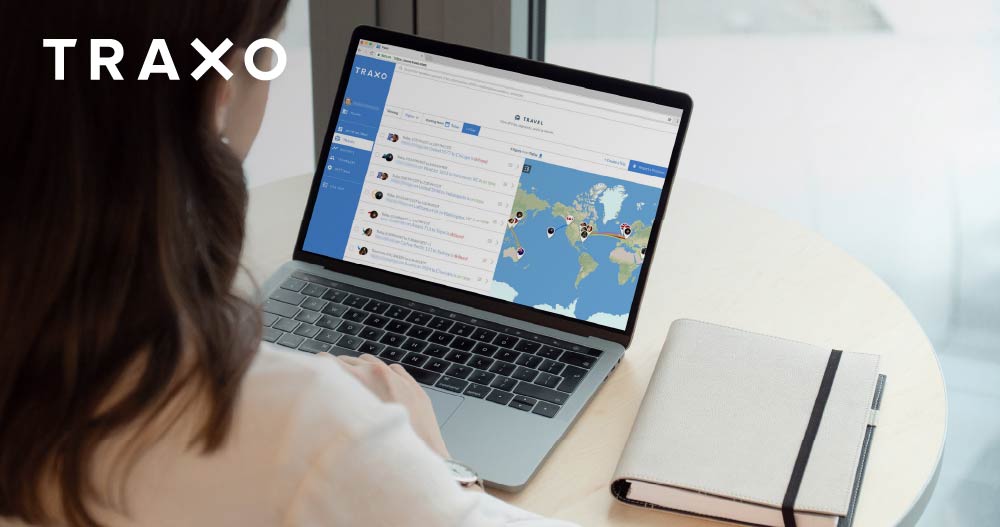
Using Data for Better Travel Management: What Does Traxo Do?
You may be wondering, "What does Traxo Do?" Traxo helps organizations audit their corporate travel programs by providing full visibility into travel bookings, regardless of the booking source, well before trips actually happen. By parsing booking details from 100,000+ air, car and hotel suppliers, Traxo provides travel managers with comprehensive

2022 Work Trends: Changes in Business Travel and Daily Operations
While the world faces emerging viral outbreaks, inflation and air travel disruptions, business travel continues to rebound from its mid-pandemic low—though its full recovery timeline has been pushed to 2026.
Until recently, businesses went into fight-or-flight mode each time a new COVID variant surfaced, which caused the height of cancellations,

How Complete Travel Data Supports Corporate Sustainability
Matt Griffin, Traxo
As our environment shifts, the importance of corporate sustainability grows stronger. As individual contributors and corporations, the actions and impact that we make together could not be more important than acting to offset our carbon footprint now.
The lasting impact of our actions plays an integral part in the Earth future generations
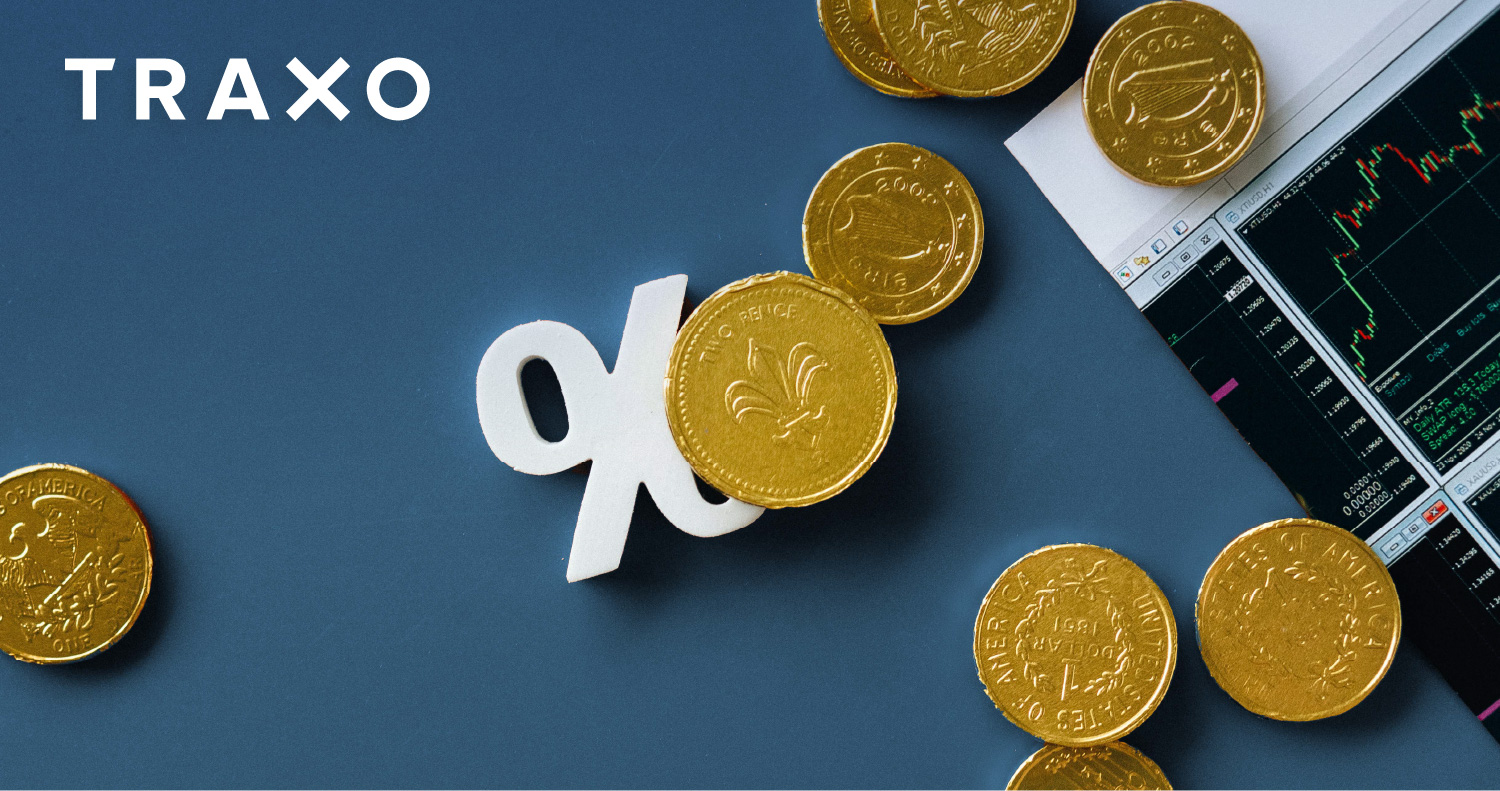
Traxo Product Update: Automatic Currency Conversion
Traxo has been providing travel managers and organizations across the globe with complete trip visibility, providing consolidated reporting and ease of locating travelers before, during, and after trips. We’ve recently taken Traxo’s reporting to the next level by launching computed prices , a new feature to automatically convert all travel data

6 Tips for Managing Bleisure Travel
A bleisure trip is what you get when you blend a business and a leisure trip together — a concept that is no stranger to modern business travelers or travel managers. An example of a bleisure trip would be an employee traveling to San Francisco for a business conference at their company’s expense and then tacking on a couple days for a quick jaunt

Why You Should Use a Travel Aggregator for Business Travel Data
Imagine waking up to news headlines that war has erupted , a political crisis has ensued, or a newly identified virus has begun to rapidly spread. As your organization's appointed travel manager, would you be scratching your head, wondering if you have employees in the affected region, or would a quick check of your travel aggregator let you know

4 Ways to Ensure Business Travel Safety During International Conflict
Many organizations had offices, work-from-home employees, and travelers visiting Ukraine when Russia invaded on February 24th, 2022. Regardless of why employees were in the country, organizations had a legally binding duty of care to their team members. Before they could ensure employees were out of harm's way, they needed to locate them. Today,

3 Aspects of an Effective Price Assurance Strategy
What is price assurance.
Price assurance is a corporate travel savings strategy made of three components — supplier negotiations, rate auditing and re-shopping. Technologies that continually audit rates and re-shop for discounts are crucial to ensuring your suppliers adhere to your contracted discounts and non-negotiated bookings are optimized.

4 Reasons Why Travel Managers Need Access to Detailed Business Travel Analytics
The role of a travel manager often varies with the size and scale of organizations. Global organizations may have large, complex travel programs, typically managed by a team of corporate travel professionals . Whereas small to medium-sized businesses may only have a single point of contact managing the travel program. Regardless of the size of your
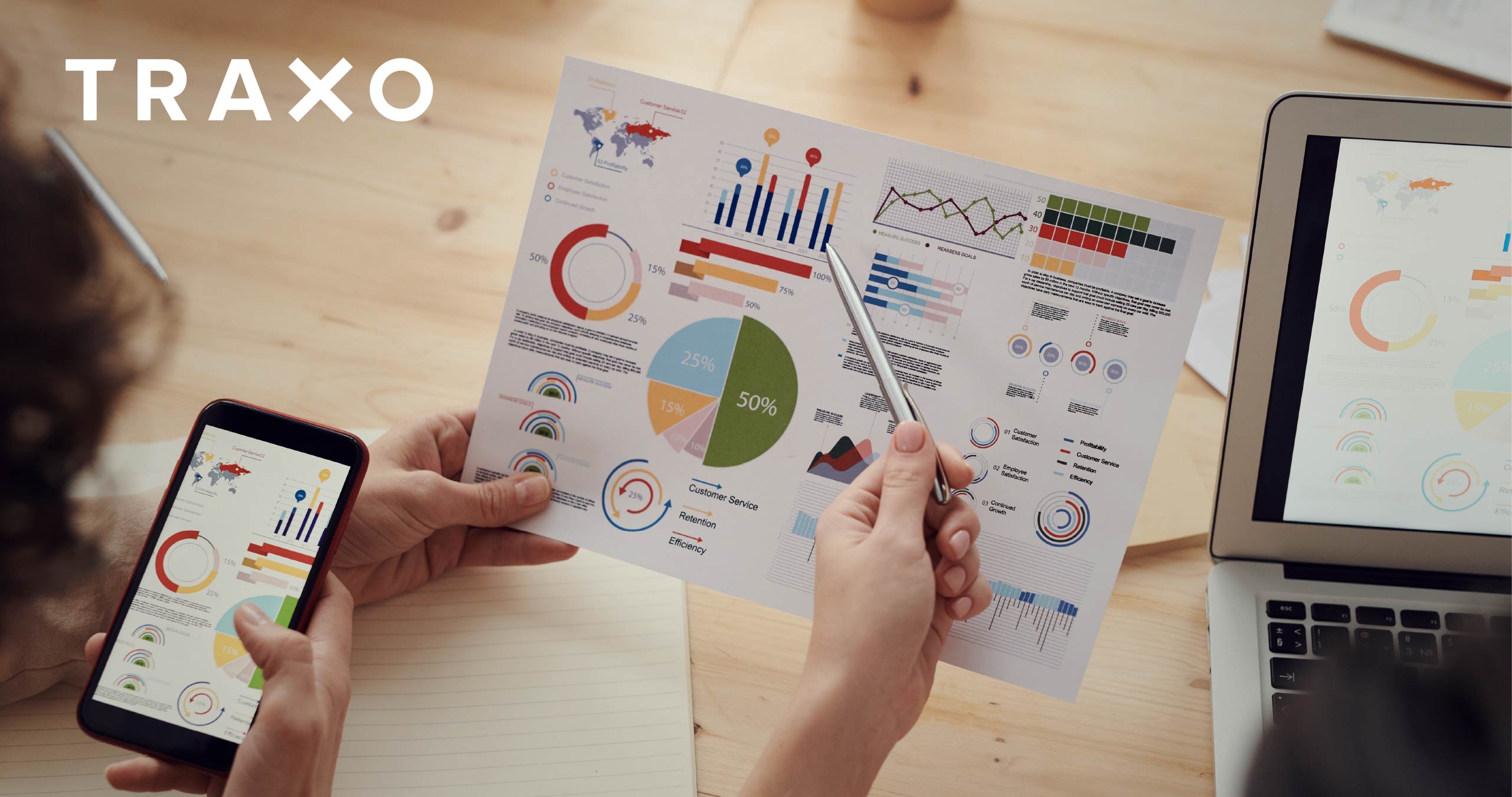
The Benefits of Using Traxo to Manage Multiple TMCs
Having multiple travel management companies (TMCs) supporting an organization is common in today’s business sector, especially for those with a global presence. This fragmentation makes leveraging a travel program data aggregation and auditing solution mission-critical.
What Are TMCs (Travel Management Companies)?
TMCs, travel management companies

Corporate Travel Technology: 3 Travel Management Technologies Every Business Should Implement
New, industry-leading corporate travel t technologies are emerging all the time. We’ve also witnessed businesses reinventing themselves to stay relevant as the world changes around us. To continue future-proofing corporate travel programs, there are three key areas where travel managers should focus:
- Ensuring access to complete pre-trip travel
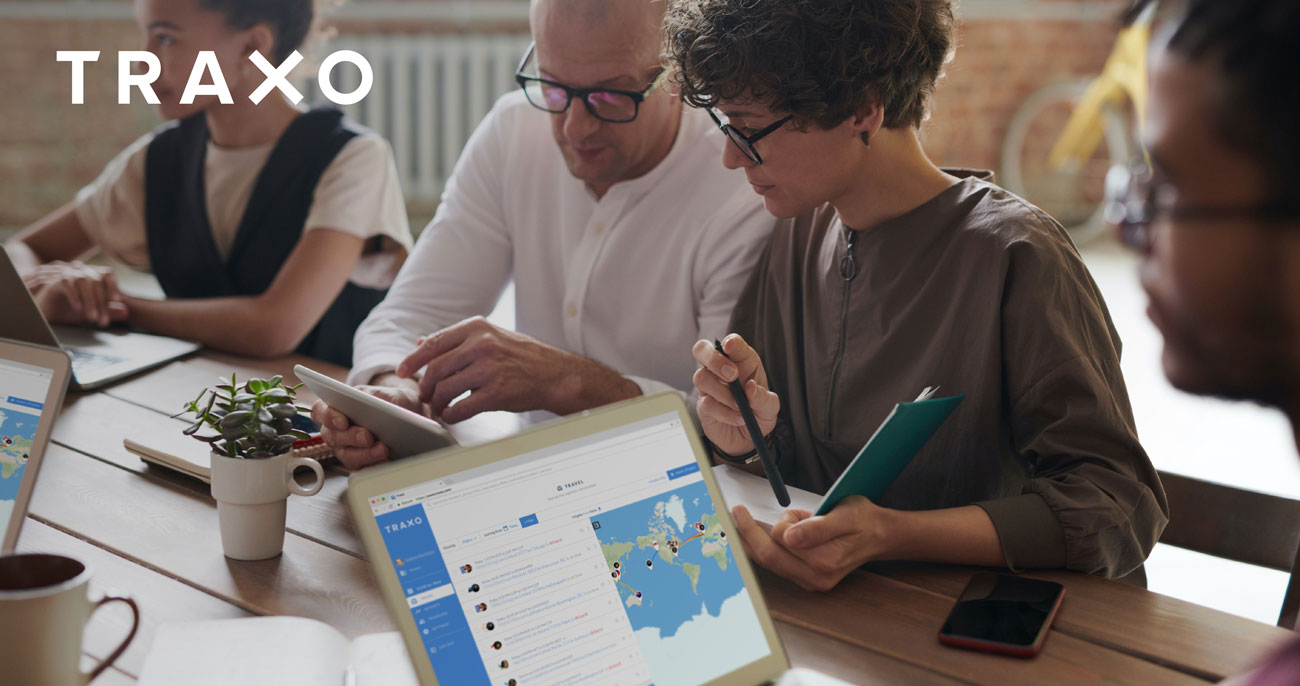
Corporate Travel Program Policy Types
A well-written corporate travel policy provides guidance for business travelers while helping organizations influence behavior, manage spend, utilize preferred suppliers , and keep travelers safe. Despite the numerous benefits a travel policy provides, travel managers still face policy compliance challenges.
How do you move the needle on
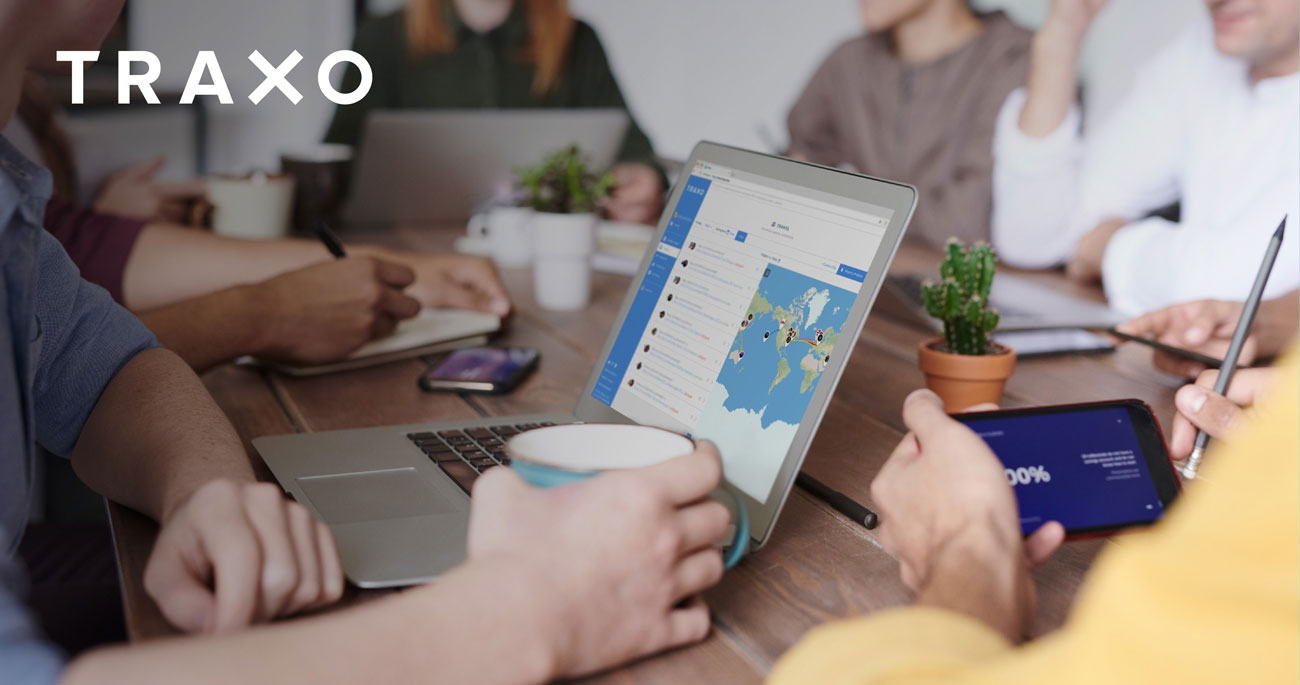
Updating Your Travel Program: 5 Corporate Travel Policy Best Practices
Once you’re familiar with the three corporate travel program policy types – mandated, flexible, and hybrid – it’s time to decide what comes next. Do you need to make changes, and if so, what are the corporate travel policy best practices you should follow?
Before diving headfirst into policy changes, let’s take a step back to evaluate the entire
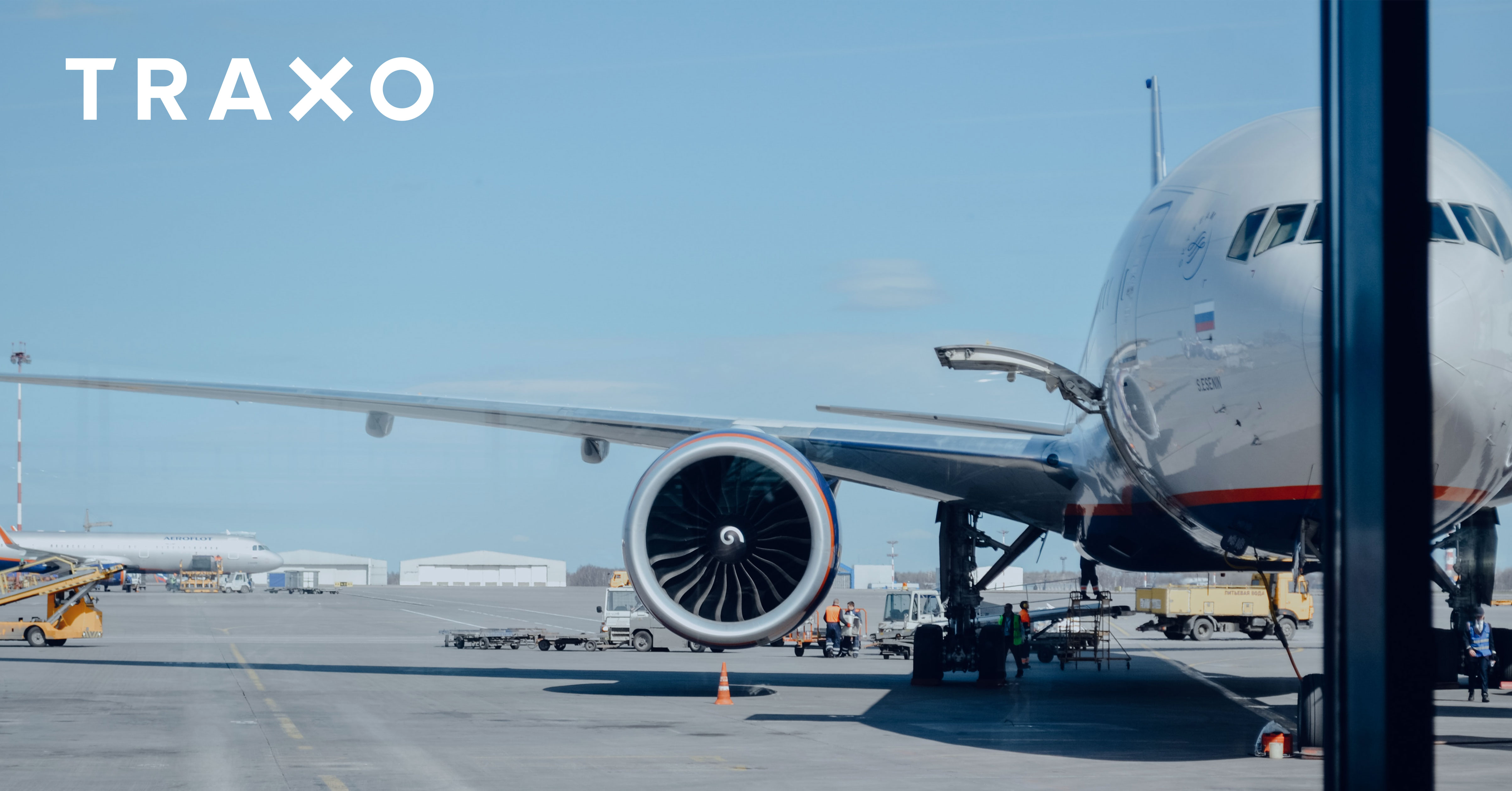
Full Data Visibility: The New Table Stakes For Corporate Travel
Andres Fabris
As the global economy begins to reopen, corporate travel teams worldwide are planning for how best to restart their company’s business travel activity. Most firms have made it through the initial “triage” stage of the pandemic. Now, teams are taking stock of how their travel programs performed in the midst of the crisis, in order to assess how
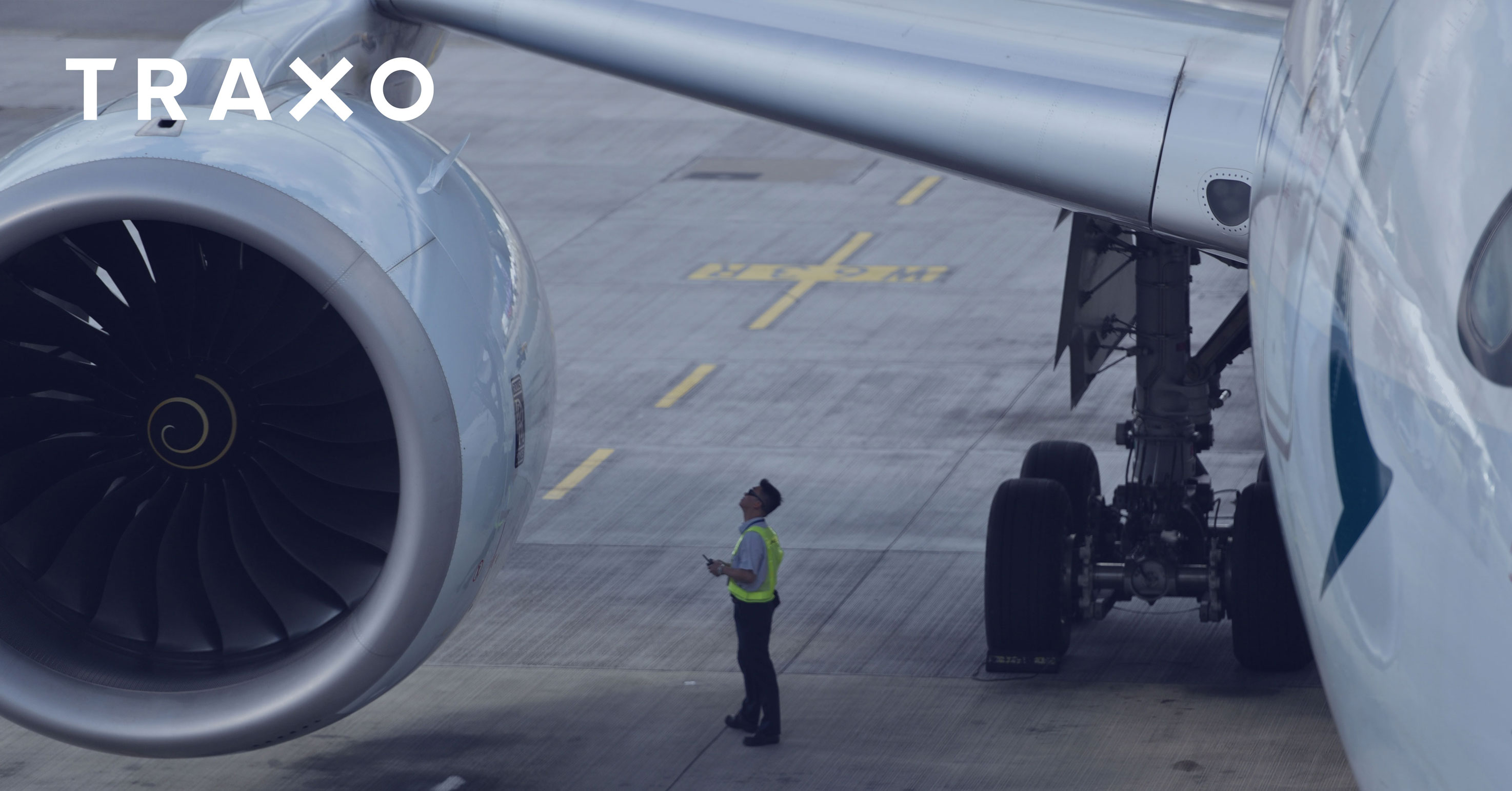
Traxo and Your TMC, Ensuring Your Travel Program is Prepared
Uncertain times – I have lost count of how many times I heard the phrase “uncertain times” over the last two months. Since the spread of COVID-19 began, the world has certainly been faced with innumerable challenges on every imaginable level - physically, mentally, spiritually, and more, especially in the realm of business travel. There are many

COVID-19 and Corporate Travel: Steps to Take Now for What Comes Next
Cara Whitehill
Travel managers have been on the front line of corporate travel’s response to the COVID-19 outbreak. Companies are in varying stages of dealing with the outbreak, but we’ve heard three common themes in how travel teams are approaching this unprecedented new reality.
Three Ways Travel Managers Are Approaching COVID-19
- Employees first – Ensuring

China, Coronavirus, Corporate Travel and Duty of Care
If your CEO or head of risk management walked into your office today and asked you how many employees recently traveled to China, and hence could be at risk for exposure to coronavirus, how confident are you of your answer?
Importance of Data Visibility During the COVID-19 Outbreak
The swift outbreak of the coronavirus (now known as COVID-19)

Traxo and Data Privacy: FAQs
We frequently get questions from prospective clients regarding data privacy and security, and how Traxo's services meet legal requirements for both areas. For corporate travel managers seeking to understand their booking blindspots, we've compiled some of the most common questions and our responses, which can be shared with internal legal and IT

Traxo at ACTE 2018: Off-Channel Spend Takes Center Stage
The Traxo team was in New York City last week for the annual ACTE Global Summit and enjoyed the opportunity to connect with hundreds of corporate travel managers and buyers. Our booth at InterACTE was busy nonstop! Thanks to all who stopped by to say hello -- we hope we helped shed some light on the challenges of managing your off-channel

Traxo Update: SOC 2 Type II Achieved
In an era where data security and privacy are paramount concerns, Traxo has announced its successful completion of the Systems and Organizational Control (SOC) 2 Type II examination. This achievement reinforces Traxo's commitment to maintaining the highest level of security. The in-depth audit, conducted by Dansa D'Arata Soucia LLP , provided an

Mandatory Emissions Reporting: Implications for Global Corporate Travel
Post-pandemic recovery has ushered in an era where the environment and sustainability are paramount. For the travel industry, the spotlight is on new mandatory emissions reporting standards. As the The World Travel & Tourism Council (WTTC) points out , navigating this evolving landscape requires commitment and innovation. Let's delve into how

Travel Data Security: What is Pen Testing?
You’ve likely experienced a cyber attack at some point during your career or personal life. For example, you may have had an account hacked into or received an alarming message from a service provider that there has been a systems data breach and your personal details were compromised. With larger-scale cyberattacks, these often go unnoticed or
There’s always more to know.
Subscribe to our mailing list for the latest product news, events, webinars, and industry insights.
Get the latest from Traxo
Corporate travel management is a dynamic field. Join our mailing list to keep abreast of the latest news on Traxo products and key industry insights.
- Platform for managers of modern travel programs
- Travel Program Savings
- NDC Visibility
- Partners spanning all functions for a smarter travel program
- Resources for smarter travel program management
- Blog on the latest travel management trends
- Traxo Traveler for personal itineraries
- NDC Tracker for the latest NDC updates
- Developer Center
- Service Status
- Talk to an Expert
- About Traxo
- Affiliate Program
- Privacy Policy
- User Agreement
- EU Data Protection
- Travel Agents
- Inbound Tour Operators
- Outbound Tour Operators
- Airline Vacation Companies
- Success Stories
Data Analytics: Creating More Value, Variety, and Visibility for the Travel Industry
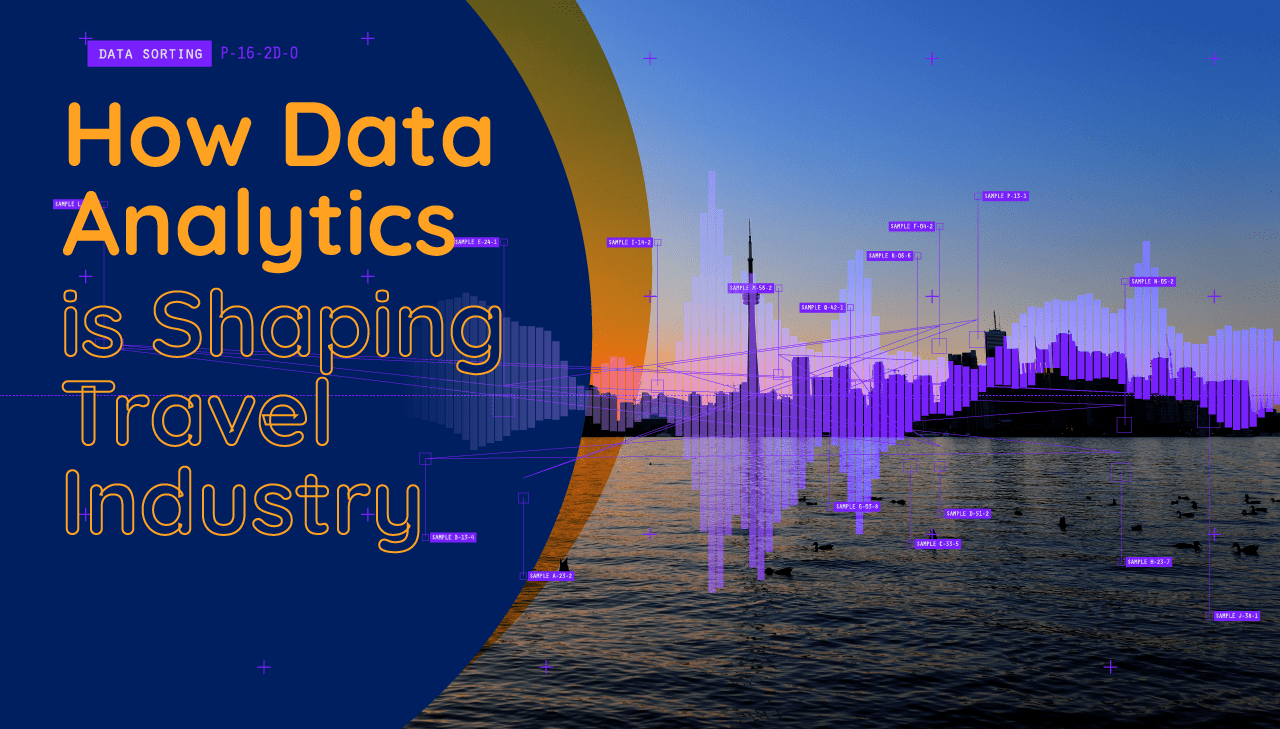
The travel industry is one of the most dynamic and complex sectors in the world, with multiple stakeholders, such as travelers, travel agencies, vendors, and partners, involved in creating and delivering travel products and services. The travel industry also faces many challenges and opportunities, such as understanding and then adapting to customer behavior, responding to unpredictable global events, and embracing evolving technology without introducing risk.
For leaders in upper management, this all adds up to complex, fateful decision-making. These business-driving choices should be based on non-stop data that is recorded, stored, and turned into insight. The technologies emerging today designed to slice and dice this data into meaningful and practical business tactics are staggering.
Too often, though, it’s either soloed or ignored — a lost opportunity. The untapped potential is enormous; leveraging it would be nothing less than transformative to most travel agency firms.
Big Data, Big Results
It all begins with data analytics: the process of collecting, organizing, analyzing, and interpreting large amounts of data to generate those insights and make informed decisions. Data analytics in the travel industry can help agencies understand the needs and expectations of travelers, optimize the performance and profitability of travel businesses , and create innovative and personalized travel experiences. In this blog post, we will focus on how data analytics is shaping the travel industry, specifically from the perspective of travel agencies.
Benefits Abound
If we think back to our introduction, a complex matrix of participants, products, and business processes make up our source of Big Data. Depending on how well you can integrate it all, the opportunities for business analytics in the travel industry are endless. Not all of the options below are relevant (or easily managed) by every type of agency, but choosing a few to invest in and focus on will drive up your bottom line.
As you read, keep this important fact in mind: Some of these can be created and managed in-house, some completely outsourced, and many often take the form of a third-party solution brought in-house to be customized and managed by your team.
- Travel arrangements : Data analytics can help travel agencies plan and book trips based on customer data (such as preferences, budget, and availability), market data (such as prices, options, and deals), and transaction data (such as bookings, cancellations, changes, and payments). For example, data analytics can help travel agencies customize itineraries by using recommendation systems that suggest the best destinations, activities, and attractions for each customer. Not only does this help accelerate the process and remove the “misfire factor” of a recommendation that doesn’t pan out, but it also delights customers who feel as if you have read their minds — when all you’ve been doing is deploying technology to pay attention to every detail.
- Affordable travels : Data analytics can help travel agencies identify affordable itinerary plans based on budget data (such as customer spending limits and travel costs). Data analytics can also help travel agencies to leverage discount data (such as promotions, loyalty programs, and partnerships) and operational data (such as inventory, distribution, and operations) to reduce costs. In particular, data analytics can help travel agencies optimize inventory by using demand forecasting that predicts the future demand for different travel products and services. This helps your firm to, say, reserve the right blocks of travel reservations, way in advance, for your clients.
- Advice on weather conditions : The most carefully-planned ski vacation is a dud if the weather’s too warm, and the most adventurous hiking trip can cross the failure threshold if the rain doesn’t stop. Data analytics can help travel agencies provide advice on weather conditions based on weather data — real-time and historical weather data from various sources and locations. Travel agencies can even leverage sentiment analysis that analyzes customer feedback on social media and other channels to understand how weather affects their travel experience.
- Hotel reservations and car rentals : Data analytics can help travel agencies to make hotel reservations and car rentals based on hotel data (such as preferences, ratings, reviews, and availability) and car rental data (such as preferences, ratings, reviews, and availability). Data analytics can also help travel agencies to negotiate rates and terms with hotels and car rental companies as price comparison s compare the prices and options of different hotels and cars from various sources. Clients are doing this themselves, manually, online, so offering them an automated analysis is a valuable offering to lock in loyalty.
- Proper travel documentation : This one is truly a value-add differentiator. Travel data analytics can help ensure clients have proper travel documentation based on travel regulation data (such as visa requirements, passport validity, health certificates, insurance policies, and other documents for different destinations). For example, text mining can extract relevant information changes or updates in travel regulations from unstructured text sources such as websites, blogs, news articles, etc.
- Customer satisfaction : Data analytics can help travel agencies measure and improve customer satisfaction based on feedback data (such as surveys, reviews, ratings, social media, and other channels). Data analytics can also help travel agencies to analyze customer behavior, preferences, expectations, and satisfaction levels. Identify customer segments, target markets, loyal customers, and potential customers.
- Marketing strategies : Data analytics can help travel agencies design and implement effective marketing strategies based on market data (such as market trends, customer demands, competitor actions, and industry opportunities). Data analytics can also help travel agencies to create personalized offers, promotions, campaigns, and content for their customers. Every sector experiencing its digital transformation has discovered that personalization is the long-sought-after key to tailoring marketing messages and content to each customer’s interests and preferences.
- Business intelligence : While many of the fascinating options above can be considered optional, this aspect of data analytics should take priority as a core tool for focusing on the hard-core numbers driving performance data (such as revenue, profit margin, conversion rate, customer retention rate, etc.). With dashboard s that visualize the key performance indicators in a user-friendly interface, BI helps travel agencies empirically identify strengths, weaknesses, opportunities, and threats in their business environment, to make the data-driven decisions to improve their business outcomes.
Why isn’t everyone doing it?
If all this is true, why aren’t all agencies relying heavily on working through all this data? There are four completely valid reasons, as frustrating as that may be. (Spoiler – we’ll end with a way to get the job done and avoid these obstacles.):
- Cost : Creating your own data analytics solution traditionally requires investment in hardware, software, data storage, data integration, data quality, data security, and data governance. Some travel agencies may not have the budget or resources to afford these costs or may not see the ROI in the short term. Indeed, seeing is believing, and many do see the results … once the competition is already offering it.
- Complexity : Data analytics involves dealing with large volumes, variety, velocity, and veracity of data from multiple sources and formats. Some travel agencies may not have the in-house skills, expertise, or tools to handle this complexity or face challenges in aligning their data with their business goals and strategies.
- Culture : Data analytics requires a culture of data-driven decision-making, where data is valued, trusted, and shared across the organization. Some travel agencies may have a culture of “gut feeling,” tradition/experience, or personnel hierarchy, where data is ignored, doubted, or hoarded by different functions and units. This is common in almost all business sectors, and often increases with the size of the company and layers of management.
- Compliance : Data analytics requires compliance with various laws and regulations regarding data privacy, security, and ethics. Some travel agencies may not be aware of these laws and regulations or have the policies and procedures to comply with them. Others may simply be nervous about taking on the responsibility, especially with corporate travel data.
We promised you a solution: you don’t need to build it yourself or rely on generic reports and studies.
Deploy a travel-oriented data platform designed, configured, and supported by experts focusing on this one core task: collecting data (merging yours with external sources) and turning it into easily understood, empirical evidence to guide business leaders. Business Intelligence dashboards hide the complexity from those who do not need granular details but want to leverage clear trends, understand triggers of successes and failures, and plan their next move based on real-time information. This isn’t a task for an all-purpose ERP/BI package, but rather for a bespoke platform designed to provide this one benefit through a toolkit that’s incredibly complex on the back end, but quick and user-friendly on your screen.
In a competitive, dynamic business with delicate profit margins per transaction, travel agencies need everything at their disposal to stay a step ahead. Data Analytics represents a broad list of applications and benefits, simultaneously serving two purposes: The agency improves its services, increases its profitability, and enhances its competitiveness, while its customers are delighted with more engaging, personalized, and memorable travel experiences.
Subscribe to our newsletter
Let's go for a journey
Schedule a meeting
More Resources
10 best accounting software for travel agencies, why choose saas travel erp software, 10 best crm tools for travel agencies in 2024.

- Brand Resources
- Economic Impact
- WTTC Research Hub
- Insights & Publications
- Knowledge Partners
- Data Enquiries
- Sustainability Hub
- Hotel Sustainability Basics
- Nature Positive Travel & Tourism
- Social Impact
- Community Conscious Travel
- Security & Travel Facilitation
- Women Empowerment
- Destination Spotlight - SLO CAL
- SafeTravels: Global Protocols & Stamp
- SafeTravels Stamp Application
- Governments
- Global Summit
- Upcoming Events
- Event Photography
- Hosting a Summit
- Event Enquiries
- Our Members
- Our Associates Community
- Membership Benefits
- Enquire About Membership
- Sponsors & Partners
- Press Releases
- Press Enquiries
- Consumer Travel Blog
- ONEin330Million Campaign
- Reunite Campaign

Sustainable Travel & Tourism
Travel & Tourism growth is outpacing that of the global economy, and while WTTC data shows that the sector’s environmental footprint is being decoupled from its economic growth, we must accelerate this trend to meet the UN Sustainable Development Goals, Paris Climate Agreement and Convention on Biological Diversity. It is essential, that together, we ensure that tourism growth is sustainable & inclusive, contributing positively to the communities, natural ecosystems, and cultural heritage upon which our sector depends.
Our initiatives
WTTC works on a number of sustainable tourism initiatives with leading associations & organisations to ensure that Travel & Tourism benefits people and businesses, as well as nature & the environment. These include:
Environmental and social data
Research and guidance.
Sustainable Travel & Tourism relies on robust data to inform management. Therefore, WTTC has expanded its economic impact reporting to include the environmental and social footprint of Travel & Tourism across 185 economies – both direct impacts and across its value chain. Indicators of the environmental and social research (ESR) include greenhouse gas emissions (GHGs), water use, energy use and composition, pollutants, resource extraction, as well as the gender, age and wage profiles of Travel & Tourism employment.
Explore in-depth the data and associated analyses and factsheets on the dedicated ESR microsite:

We create a wide range of sustainable tourism reports, roadmaps and guidance covering climate, environment and social topics. You'll find much of this on our Research Hub as well as through the below links.

According to WTTC’s Environmental and Social Research, Travel & Tourism contributes approximately 8% to overall global GHG emissions. While the sector’s emissions intensity has steadily fallen since 2010, we must start decreasing our sector’s absolute emissions in order to achieve Net Zero Travel & Tourism by 2050. WTTC therefore works with partners to recommend industry-specific decarbonisation pathways and ambitions, Net Zero tourism guidance and roadmaps covering scopes 1-3, and baseline data to support decision-making.
%20(1).jpg)
Environment
Travel & Tourism is intrinsically linked to biodiversity and nature. Over half of the sector’s demand is driven by the desire to explore nature and it is one of six economic sectors with over 80% of its goods and services highly dependent on nature. At the same time, tourism revenue and the presence of visitors, fuel conservation efforts, protected areas, and local economies. The sector's interdependence with our natural surroundings places it in a unique position to act as a Guardian of Nature. As such, WTTC works with partners to deliver critical guidance on areas such as single-use plastic reduction strategies, freshwater management roadmaps, and Nature Positive approaches to integrating biodiversity safeguards and protecting and restoring nature.
Data, research and guidance are great! But we need action, and we need it now to create a more sustainable future for Travel & Tourism. Below are some of our top sustainable tourism initiatives:
- Nature Positive Vision for Travel & Tourism: Positioning T&T as a Guardian of Nature
.jpg)
Key publications
Some of our other key publications include:

Nature Positive In Action

A Net Zero Roadmap for Travel & Tourism

Navigating the Sustainability Journey: The Impact of Mandatory Reporting on Travel & Tourism

Rethinking single use plastic products SUPPs in Travel & Tourism

The Environmental Impact of Global Tourism Report
Related events and webinars
Here are our webinars and events that are related to sustainability:
- Monitoring our Footprint and Steering Sustainable Growth
- Treading the Path to Decarbonisation
- WTTC at New York Climate Week 2023
- COP26 - Driving Climate Action: A Net Zero Roadmap for Travel and Tourism

Tourism statistics and the use of social media data

- PDF - Tourism statistics and the use of social media data
National Public Data confirms massive data breach included Social Security numbers
Social security numbers, names, addresses, email addresses and phone numbers were in the 2.9 billion records within a data breach. security firm pentester.com tool tells you if your data is involved..
National Public Data, which aggregates data to provide background checks, has confirmed it suffered a massive data breach involving Social Security numbers and other personal data on millions of Americans.
The Coral Springs, Florida, company posted on its website a notice this week that "there appears to a have been a data security incident that may have involved some of your personal information. The incident is believed to have involved a third-party bad actor that was trying to hack into data in late December 2023, with potential leaks of certain data in April 2024 and summer 2024."
News about the breach first came from a class action lawsuit filed in U.S. District Court in Fort Lauderdale, Florida, and first reported on by Bloomberg Law . Stolen from National Public Data (NPD) were 2.9 billion records including names, addresses, Social Security numbers and relatives dating back at least three decades, according to law firm Schubert, Jonckheer & Kolbe , which filed the suit.
NPD said the breached data included names, email addresses, phone numbers and mailing addresses, as well as Social Security numbers. The company said it is cooperating with investigators and has "implemented additional security measures in efforts to prevent the reoccurrence of such a breach and to protect our systems."
National Public Data breach: Why you should be worried about massive data breach and what to do.
Identity protection: How and why to freeze your credit
How to check to see if your Social Security number, data were exposed
Cybersecurity firm Pentester said it got the data and created a tool you can use to see if your information is in the breach – it shows names, addresses, address histories, and Social Security numbers. You will find it at npd.pentester.com .
Because financial institutions use Social Security numbers on applications for loans and credit cards and on investments, having that information that information available to bad actors poses a serious risk, Pentester.com co-founder Richard Glaser said in an advisory on the company website.
He also suggested freezing credit reports. "Names, addresses and phone numbers might change, but your Social Security number doesn't," Glaser said.
Your wallet, explained. Sign up for USA TODAY's Daily Money newsletter.
Data breach: How to protect your credit
NPD also advised consumers to "closely monitor your financial accounts and if you see any unauthorized activity, you should promptly contact your financial institution." Consumers might want to get a credit report and get a fraud alert on their credit file, the company said.
Consumers should do more than that and freeze their credit report, Odysseas Papadimitriou, CEO of personal finance site WalletHub, told USA TODAY. “Placing a fraud alert is not as effective as freezing your report," he said.
"A fraud alert is more of a heads up to lenders, which they can easily ignore. It doesn’t do much in practice," Papadimitriou said. "A freeze, on the other hand, stops fraud in its tracks by preventing identity thieves from opening accounts in your name.”
He and other security experts suggest consumers take that step because the personal data is likely in the hands of hackers.
The class action suit alleges it was cybercriminal group USDoD that accessed NPD's network and stole unencrypted personal information. Then the group posted a database it said had information on 2.9 billion people on the dark web on about April 8, 2024, seeking to sell it for $3.5 million.
Follow Mike Snider on X and Threads: @mikesnider & mikegsnider .
What's everyone talking about? Sign up for our trending newsletter to get the latest news of the day

Social Media Influences More of These Travelers Than Others
I n the digital age, having a keen awareness of which consumers are most likely to be swayed by social media can give any travel marketer an edge in working to convert spectators into actual travelers. While racking up likes and shares on socials is important these days, what really matters is whether companies can convert that interest into real-life bookings.
A recent study by Phocuswright has shed light on the growing influence of social media on travel decisions, particularly among younger travelers. According to the report, titled " F is for Funnel: Social Media and the Path to Travel Purchase ", two out of three travelers under the age of 55 indicated that social media content played a pivotal role in their decision-making for a recent trip. The study also highlighted that frequent travelers are more likely to use digital tools, including social media, when planning their trips.
Some travel providers are already adapting to this shift in how social media is influencing consumers. Earlier this year, GetYourGuide, a leading platform for booking tours and activities, announced the hiring of a full-time content creator specifically for TikTok. Similarly, Klook, a Singapore-based travel activities platform, recently partnered with TikTok to integrate booking capabilities directly into the app, aiming to streamline the user journey from inspiration to sale.
However, there is still skepticism within the industry about the effectiveness of social media in driving actual bookings. Christian Watts, founder of Magpie Travel, expressed doubts on LinkedIn about whether travel companies can successfully tie together the various levels of the sales funnel to achieve conversions. Other suppliers believe the challenge lies in educating themselves on how to effectively use video marketing to drive bookings.
"Video marketing follows the same dreaming, planning, booking, experiencing, and sharing phases of travel." said travel and tourism advisor Peter Syme. "Video needs to be produced for all these phases except experiencing. AI will mean that video has to be produced differently depending on the desired outcome as AI will scrape the video and create itineraries and things to-do lists. Watch for video reviews exploding in the sharing phase." Syme also suggested that Google is likely to integrate booking capability into its owned platform YouTube, which Klook is already working with.
Klook's recent moves indicate its intention to focus on attracting Millennials, particularly in Asia, where over 60 percent of the global Millennials, 1.1 billion of them, reside. The company's Kreator initiative, launched last year, aims to connect travel providers with potential travelers. A media report in July also uncovered that TikTok was testing local services, such as travel, in Southeast Asia.
Phocuswright’s report also demonstrated that many travelers begin gathering information on potential destinations even before setting specific dates for their trips. Interestingly, the report also found that factors such as gender and household income did not significantly affect the likelihood of social media influencing travel decisions. However, it noted that international travelers are more inclined to make travel decisions based on social media content than those planning domestic trips.

Integrating Household Travel Survey and Social Media Data to Improve the Quality of OD Matrix: A Comparative Case Study
Ieee account.
- Change Username/Password
- Update Address
Purchase Details
- Payment Options
- Order History
- View Purchased Documents
Profile Information
- Communications Preferences
- Profession and Education
- Technical Interests
- US & Canada: +1 800 678 4333
- Worldwide: +1 732 981 0060
- Contact & Support
- About IEEE Xplore
- Accessibility
- Terms of Use
- Nondiscrimination Policy
- Privacy & Opting Out of Cookies
A not-for-profit organization, IEEE is the world's largest technical professional organization dedicated to advancing technology for the benefit of humanity. © Copyright 2024 IEEE - All rights reserved. Use of this web site signifies your agreement to the terms and conditions.
- Topics ›
- Artificial intelligence (AI) use in travel and tourism ›
Travel Inspo: Insta & TikTok Beat AI
The possible applications of generative AI are practically limitless . Tools like ChatGPT can be used to craft emails, write code and solve all kinds of problems in a professional context. But they’re also very helpful for private use, for example when planning a vacation or a weekend getaway. AI tools can help you find a nice restaurant, a flight connection or plan the itinerary for an entire trip.
Like all applications for AI tools, their use as a personal travel assistant is still in its infancy and many people probably don’t even know what AI is capable of in the travel context. According to Deloitte’s 2024 summer travel survey , just 10 percent of Americans who plan a summer vacation this year plan to use AI tools for inspiration or information regarding their upcoming trips. AI use is most common among Millennials, where 17 percent of travelers have used ChatGPT or similar tools for trip planning.
While AI tools are rarely used by travelers looking for inspiration, the same cannot be said for short-form videos commonly found on social media platforms such as TikTok and Instagram. Especially young people tend to get inspiration from such videos, as Deloitte’s survey shows. 44 percent of GenZ travelers use social media videos for travel inspiration, which is not a huge surprise considering the popularity of TikTok in this age group.
Description
This chart shows how many U.S. travelers use AI tools or short social media videos for travel inspiration and information.
Can I integrate infographics into my blog or website?
Yes, Statista allows the easy integration of many infographics on other websites. Simply copy the HTML code that is shown for the relevant statistic in order to integrate it. Our standard is 660 pixels, but you can customize how the statistic is displayed to suit your site by setting the width and the display size. Please note that the code must be integrated into the HTML code (not only the text) for WordPress pages and other CMS sites.

Infographic Newsletter
Statista offers daily infographics about trending topics, covering: Economy & Finance , Politics & Society , Tech & Media , Health & Environment , Consumer , Sports and many more.
Related Infographics
Stock market, summer of 2024 has been a rollercoaster ride for investors, asian countries lead tourism boom of the 2010s, sponsored post by booking.com, u.s. hoteliers feel upbeat about their business, sponsored post by booking.com, online travel platforms increase bookings for the vast majority of u.s. hotels, research & developemt spending, the most emission-intensive industries rarely focus on r&d, tourism & travel, where travellers (don’t) look for unique experiences, passenger airlines, the most popular airlines in the u.s., most travel to visit friends and family, aviation industry, how much does jet fuel cost, who’s got a samsung phone, semiconductor manufacturing, how the ai boom influenced tsmc’s bottom line, international travel expands faster than domestic in the growing market.
- Who may use the "Chart of the Day"? The Statista "Chart of the Day", made available under the Creative Commons License CC BY-ND 3.0, may be used and displayed without charge by all commercial and non-commercial websites. Use is, however, only permitted with proper attribution to Statista. When publishing one of these graphics, please include a backlink to the respective infographic URL. More Information
- Which topics are covered by the "Chart of the Day"? The Statista "Chart of the Day" currently focuses on two sectors: "Media and Technology", updated daily and featuring the latest statistics from the media, internet, telecommunications and consumer electronics industries; and "Economy and Society", which current data from the United States and around the world relating to economic and political issues as well as sports and entertainment.
- Does Statista also create infographics in a customized design? For individual content and infographics in your Corporate Design, please visit our agency website www.statista.design
Any more questions?
Get in touch with us quickly and easily. we are happy to help.
Feel free to contact us anytime using our contact form or visit our FAQ page .
Statista Content & Design
Need infographics, animated videos, presentations, data research or social media charts?
More Information
The Statista Infographic Newsletter
Receive a new up-to-date issue every day for free.
- Our infographics team prepares current information in a clear and understandable format
- Relevant facts covering media, economy, e-commerce, and FMCG topics
- Use our newsletter overview to manage the topics that you have subscribed to
Designed for iPhone
- 1.0 • 1 Rating
- Offers In-App Purchases
iPhone Screenshots
Description.
Ultimate Travel Social App For Backpackers, Nomads, Expats, and Solo travellers. Your must-have Social Travel app GoLoca, the ultimate travel companion app designed for adventurers, backpackers, nomads, expats, and solo travelers alike. With GoLoca, your journey becomes more than just a trip; it becomes an opportunity to connect, explore, and share experiences with like-minded individuals from around the globe. Connect with Fellow Travelers: Say goodbye to solo journeys and hello to a vibrant community of travelers just like you. GoLoca makes it easy to meet new friends, find travel buddies, and forge meaningful connections with people who share your passion for exploration. Whether you're backpacking through Europe, exploring hidden gems in Asia, or embarking on a solo adventure across the Americas, GoLoca connects you with fellow travelers eager to share in your journey. Explore Local Communities: Experience destinations like a true local with GoLoca's immersive community features. Connect with locals who know the best-kept secrets, hidden gems, and off-the-beaten-path attractions in every corner of the world. From authentic culinary experiences to unique cultural traditions, GoLoca helps you discover the heart and soul of each destination through the eyes of those who call it home. Build Your Travel Profile: Your travels are more than just a collection of destinations—they're a reflection of who you are and the experiences that shape you. With GoLoca, you can build and personalize your travel profile to showcase your adventures, share travel tips, and inspire others to explore the world. Level up your profile as you embark on new journeys, unlock achievements, and share your travel milestones with the global GoLoca community. Compete on the Travel Leaderboard: Fuel your sense of adventure and competitiveness with GoLoca's travel leaderboard. See where you rank among fellow travelers based on your travel experiences, destinations visited, and engagement within the community. Whether you're aiming for the top spot or simply looking for friendly competition, the travel leaderboard adds an exciting dimension to your travel journey. Make Every Journey Memorable: At GoLoca, we believe that every journey should be filled with unforgettable moments, enriching experiences, and lasting memories. Whether you're embarking on a solo expedition, backpacking through remote landscapes, or immersing yourself in the vibrant cultures of bustling cities, GoLoca is your trusted companion every step of the way. Download GoLoca Today: Ready to embark on your next adventure? Download GoLoca now and join a global community of travelers who share your passion for exploration, discovery, and connection. Whether you're seeking travel inspiration, looking for new friends, or simply eager to share your adventures with the world, GoLoca is the ultimate travel companion for every adventurer. Start your journey with GoLoca today and make every moment count. GoLoca premium subscription unlocks exclusive features: * Verified badge on profile. * Access to phone/video calls. * Unlock GoLoca Challenges badges. * Direct message to private profiles(max 10/day). * Register up to 30 past trips. * Create private posting groups. GoLoca Plans: * Monthly: €0.99 * Annual: €11.88 Payments and Renewal: * Payment will be charged to iTunes Account at confirmation of purchase. * Subscription automatically renews unless auto-renew is turned off at least 24-hours before the end of the current period. * Account will be charged for renewal within 24-hours prior to the end of the current period. * You can manage or turn off auto-renew in your Account settings at any time after purchase. * Cancellation of the current subscription is allowed during the active period. Terms of Use: https://goloca.app/terms-and-conditions/ Privacy Policy: https://goloca.app/privacy-policy/ Support: https://goloca.app/contact/
Version 1.0.1
Bug fixes and enhancements.
Ratings and Reviews
App privacy.
The developer, Goloca , indicated that the app’s privacy practices may include handling of data as described below. For more information, see the developer’s privacy policy .
Data Not Collected
The developer does not collect any data from this app.
Privacy practices may vary, for example, based on the features you use or your age. Learn More
Information
- Monthly Membership $0.99
- Yearly Membership $9.90
- App Support
- Privacy Policy
How to see if your Social Security number was included in latest data breach
Massive social security data breach.
Every American's Social Security number, address may have been stolen in hack. A hacking group called USDoD claims to have stolen 2.7 billion records of personal information from Americans, including their Social Security numbers and physical addresses.
A stunning data breach involving the personal information of virtually every American – including Social Security numbers – has raised serious concerns about what cyber criminals will do with the sensitive data.
The notorious hacking group USDoD claims to have stolen 2.9 billion personal records in the U.S., UK and Canada. If it’s true, nearly every American would have some of their information included in the leak.
The breach happened late last year at National Public Data, but hackers began sharing some of the stolen data publicly in April and again this summer, the company said on its website . National Public Data sells personal information to employers , private investigators, staffing agencies and others doing background checks, The Los Angeles Times reported.
RELATED: Report: Data brokers selling personal information to US government, private entities, foreign governments
Reports say the leak includes records dating back 30 years, and cybersecurity experts warn it could fuel a rise in identity theft, fraud and other cyber crimes.
Who is behind the data theft?
Hacking group USDoD claimed responsibility for the breach at National Public Data. The group was trying to sell the entire database for $3.5 million, but a USDoD member has reportedly released most of it for free on an online marketplace for stolen personal data, according to The Times .

FILE - A notorious hacking group claims to have stolen 2.9 billion personal records in the U.S., UK and Canada. (Photo Illustration by Thomas Imo/Photothek via Getty Images)
What can hackers do with your information?
A lot of the information included in the breach is what banks, insurance companies and other businesses use when creating accounts and changing user passwords.
RELATED: AT&T hack: ‘Nearly all' customers' call, text records exposed in data breach
Using your name, Social Security number, date of birth and mailing address, a cyber criminal could open fake accounts in your name or try to reset passwords on existing accounts.
Not everything was included in the leak: Hackers didn’t steal email addresses, driver’s license photos or passport photos, which are often used to verify identities.
How to see if your Social Security number was included in the breach
Cybersecurity firm Pentester has launched a tool online for you to see if you were part of the breach.
Go to npd.pentester.com , then enter your first and last name and birth year for a list of breached accounts, including the last four digits of the leaked Social Security numbers.
How to protect your personal information
Ticketmaster breach could impact millions in 2024.
Michael Bruemmer, Vice President and Head of Experian Global Data Breach Resolution, joins LiveNOW's Austin Westfall to discuss a recent Ticketmaster data breach as hackers were able to access customers' personal information.
There are steps you can take to safeguard your personal information in the wake of increasing cyber attacks.
Experts say to monitor credit reports for possible fraudulent activity and notify credit bureaus Experian, Equifax, and TransUnion if something looks suspicious.
RELATED: Live Nation investigates Ticketmaster data breach, customer data offered on dark web
If something does look suspicious, you can ask the credit bureaus to place a freeze on your accounts to prevent anyone from opening a bank account or obtaining a credit card under your name. But don’t forget to lift the freeze temporarily if you’re buying or applying for something that requires a credit check.
It’s also important to use two-factor authentication on all your accounts, avoid using the same passwords for different logins, and make sure to routinely change all your passwords.
Money blog: Has the Nike trainer bubble burst?
Welcome to the Money blog, a hub for personal finance and consumer news and tips. Read our weekend feature on the fortunes of Nike below and let us know your thoughts in the comments box. We'll be back with live updates after the bank holiday.
Saturday 24 August 2024 12:28, UK
Essential reads
- Has the Nike trainer bubble burst?
- What you need to know from Money this week
- 'Who is Gail?': Our favourite reader comments of the week
- Gold reaches record highs - what's going on?
- Which supermarket pays staff most and offers best perks?
Tips and advice
- Best mortgage rates for first-time buyers right now
- How to spend less on school uniform
- How to get money back when purchase over £100 goes wrong
- Cheap Eats : Top Yorkshire chef shares Yorkshire pudding secrets
Ask a question or make a comment
By Mark Wyatt , Money blog reporter
The trainer market is now more diverse and competitive than ever before, and its biggest player has felt the pinch.
While new brands have been popping up and taking market share, Nike suffered its biggest single day drop in share price on record in late June.
A whopping $28bn (£21.6bn) was shaved off in market capitalisation overnight after the company's management reported an expected sale drop in early 2025.
But why has this happened?
Nike remains the largest sports retailer in the world and still has the biggest slice of market share. However, analysts say strategic decisions at boardroom level have contributed to a downturn in its fortunes - with consumer concerns and the emergence of new competition also in play.
Shift in strategy
John Donahoe became Nike's new CEO in January 2020 and was tasked with updating the company's online operation and bringing in more digital revenue.
Mr Donahoe arrived from one of the world's biggest ecommerce companies, eBay, and quickly began shifting Nike's focus towards its digital sales efforts and away from the high street.
Shortly after, the COVID pandemic hit, and the world's shoppers were forced online whether they liked it or not.
With people not going into offices to work, there was no need to buy smart, formal footwear. Comfortable, everyday shoe sales rose, and Nike's profits surged past projections.
Everything looked to be going well, so Mr Donahoe doubled down, accelerating the digital strategy and moving Nike out of hundreds of bricks-and-mortar stores.
Soon, Nike had severed a third of its relationships with sales partners.
"The consumer today is digitally grounded and simply will not revert back," said Mr Donahoe on an earnings call in 2020.
Nike believed they were the ones best able to deliver their vision straight to consumers, and they didn't need retailers like FootLocker and JD Sports diluting that as middle men.
But as lockdowns ended across the world, people returned to stores and online sales slowed, and the decisions that had been made started to be questioned.
"I think they underestimated the cultural aspect of brick-and-mortar shopping as part of the social life of young consumers," Daniel Herval, who worked at Nike between 2017-20 on some of its biggest trainers including Air Max, Jordan and Air Force 1, told the Money blog.
"Nike thought people had shifted to online, and they'd left the brick-and-mortar experience behind.
"But as soon as things started reopening, the social aspect of shopping, the community bonding aspect of shopping, returned, and Nike weren't really there."
Competition and innovation
Nike's rivals weren't going to stand still while this was happening, and sure enough, retailers that had once had Nike shoes front and centre on their shelves looked for other brands to fill the space.
Newer brands like Asics, Deckers Outdoor's HOKA and Roger Federer-backed On emerged, taking a steadily growing portion of the market share.
And those companies quickly began to show off new ideas, notably in a corner of the market that Nike has long dominated - performance running.
HOKA's thick foam soles are a huge draw for runners, while On's well-marketed (and now patented) cushioning system technology has proved popular for casuals and professionals alike.
Nike, it is perceived by some, has lagged behind in the sports lifestyle scene, too. Adidas's Samba and Gazelle lines, and New Balance's 990s, have grown in popularity - even then-Prime Minister Rishi Sunak owned a pair of Sambas ...
So where has Nike's innovation been during this time?
The air cushioning inside the soles of trainers - known as the Air Max bubble - debuted all the way back in 1978.
The last major innovation from Nike trainers, according to Mr Herval, was the introduction of their new signature material Flyknit back in 2012.
A survey of US teenagers by Piper Sandler earlier this year backed up the idea that while Nike remains the favourite, it has been losing "mindshare" to innovative brands like Hoka and On.
Nike appears to have acknowledged the problem, announcing a "multi-year innovation cycle" in April.
Two key complaints from the streets
To find out how consumers feel about Nike's shoes in 2024, there are few better places to go searching than The Basement.
Launched on Facebook over a decade ago, the online group of streetwear fanatics has just over 150,000 members from across the globe and is a go-to authority on all things street fashion, including trainers.
Need to check if the hoodie you just bought on eBay really is a vintage Ralph Lauren? Ask The Basement. Want to launch your own line of bespoke sunglasses but need advice starting a small fashion business? Ask The Basement.
Looking for consumers to tell you why fewer people are buying Nike trainers in 2024? You get the picture.
When we asked The Basement's members for their thoughts on Nike, there were two issues that came back with almost every response.
The first of those is the price point, which is now largely unaffordable for the exact demographic who historically have bought Nike's trainers in droves.
Have a look on Nike's website, and you'd be hard-pressed to find a new-release trainer costing less than £120. Most of the "hotly anticipated" shoes sit between the £150-£200 mark.
For the classic products, like the Air Max 95, a new pair starts at £174.99. Some traditionally cheaper options, like the Air Jordan 1s, are now around £130 on retailers including JD Sports, Size? and ASOS.
"£200 isn't an accessible price point," said one member of The Basement. "People have got older and smarter."
"I worked for a footwear retailer for four years," said another. "Nike's biggest killer was easily their price hikes.
"When I started collecting Jordan they were £105, within 10 years the same model is £190 - you can't justify that!"
The testimonies go on and on. As do those raising consumers' second-biggest gripe with Nike trainers - quality control.
Anecdotal reports of botched products are not hard to find, with many buyers frustrated that, after spending a lot of money on new shoes, they've received trainers covered in glue stains, with mismatched logos, missing patterns, misshaped heels and more among the complaints.
Quality control is a hands-on process that involves both manual and automated procedures, and as such it is not foolproof.
But the sheer number of reports of errors indicates this is not just a few faulty Air Forces.
There are tens of millions of hits on TikTok for the term "Nike quality control" and - spoiler alert - most videos aren't of people sharing how delighted they are with their new trainer purchases.
"Why would I spend £200 on a pair of Nike trainers that will probably arrive covered in glue stains and break after a month, when I could get a perfect pair of New Balance for £150?" asks a member of The Basement.
"Quality has taken a dive. Anyone who has ever worked for somewhere stocking Nike knows that glue smell off the pallet far too well," says another.
Bouncing back via Paris
But it's not all doom and gloom for Nike. There was a golden marketing ace up its sleeve this summer - Paris 2024.
The world's biggest brands see the Olympics as an opportunity to get in front of a global audience, and Nike is no different. Good publicity and brand image can instil customer confidence and improve share price - getting things right in Paris was key.
The sportswear giant announced prior to the Games that it would be spending more on it than it had for any previous edition.
"This will be the most investment and the biggest moment for Nike in years," Heidi O'Neill, Nike's president of consumer, product and brand, told Reuters in April.
Nike secured itself as an official sponsor for Team USA, meaning so long as the athletes performed as expected, the swoosh would be on top of the podium.
And so it was. Simone Biles won three golds in gymnastics, Noah Lyles took 100m glory and swimmer Katie Ledecky featured on the podium four times.
Lifetime Nike endorser LeBron James laced up some very on-the-nose metallic gold style trainers from his own custom LeBron 22 signature line on his way to a gold medal.
And it's not just while competing that the Nike tick gets its moment. Every US athlete received a special package containing 50 items of apparel, footwear and accessories, including "interview wear" and "village wear" to keep branding visible at every moment possible in Paris.
That was important, because Paris 2024 broke records for its worldwide audience. In the UK, BBC Sport's coverage of the games was streamed 218 million times, more than double the number recorded in Tokyo.
Across the pond, NBCUniversal's multi-platform coverage drew in record advertising money and averaged 30.6 million daily viewers.
What did that all mean for Nike? In the opening week of the Olympics, from 26 July to 1 August, it managed to increase visits to its websites, while its direct rival Adidas saw its visits decline compared with the week prior.
Importantly, data from Similarweb also showed that Nike was able to convert a lot of visits to its website into sales. And it did that more than its rivals.
"(Nike is) still a struggling brand overall," said Drew Haines, the merchandising director at retailer StockX.
"But the Olympics, it definitely drives interest in these things. Nike is the one that's really winning there."
The marketing boost provided by the Olympics won't suddenly end all Nike's perceived and real problems, but it's clearly a step in the right direction.
Even now, the share price has slowly started to recover, gaining around 14% in the last month following recent investment from US billionaire hedge fund manager Bill Ackman.
"Nike's ability to just go beyond the pure product conversation, the ability to connect to consumers, is second to none," says Mr Herval.
"It's going to take a couple of years. But I truly, firmly believe that the brand is still able to rebound."
Nike did not respond to a request to participate in this article.
By Jimmy Rice, Money blog editor
A lot of people have been scratching their chins and wondering whether the new government might be overstating the economic mess left by the previous regime.
The accusation, from the right, is that a narrative is being built to justify tax rises motivated not by necessity but ideology.
Data that's trickled in over the weeks since Rachel Reeves stepped into Number 11 - GDP growth, inflation remaining low - hasn't always helped the Labour story.
But this week, in the words of data and economics editor Ed Conway , "we had the latest public finances numbers and here the picture is considerably closer to the Reeves version than those other bits of data".
Government borrowing for July overshot expectations - and the consequences for public services and the tax burden in the October budget now look "grim", Conway wrote .
He discussed all of this in an episode of the Daily podcast, which you can listen to here or wherever you enjoy podcasts ...
Despite warning about the budget, Conway's sources suggest another route is still being considered by the chancellor, one that involves changing how the public finances are measured and judged. You can read about this here...
We also learned this week of the timeline for new EU visa rules.
UK citizens will need to pay a €7 visa-waiver charge to travel to Europe from next year. The additional charge, which is similar to the US ESTA, is part of a series of new border checks and entry requirements the EU is bringing in.
They'll apply when entering the Schengen area, which includes EU member states, plus Iceland, Liechtenstein, Norway and Switzerland.
People under 18 or over 70 will be exempt from the charge - as will those travelling to Ireland or Cyprus.
The waiver will last for three years or until your passport expires.
Its official title is the European Travel Information and Authorisation System (ETIAS), and its implementation will follow the introduction of the EU Entry/Exit System (EES). The latter will require people to have their fingerprints registered and their pictures taken on arrival to airports.
Addressing the rollout, EU home affairs commissioner Ylva Johansson said the EES will enter into operation on 10 November while the ETIAS will follow shortly after that in 2025 - likely May.
However, it is thought there could be a six-month grace period before the visas become compulsory - taking it to November next year.
On Friday morning, it was confirmed that the energy price cap would rise in October, with another hike expected in January.
"Unfortunately, a volatile wholesale market, and a country heavily reliant on imported energy has created a perfect storm for fluctuating household bills," said Dr Craig Lowrey, principal consultant at Cornwall Insight.
He argued that there may be a case for re-examining the price cap system given it's not protecting households from global energy trends.
A typical annual bill will now be £1,717 from the autumn, with £45 forecast to be added to that in the new year.
Here in Money, we examined football shirt prices as the new Premier League season got under way...
For a fuller understanding of this story, watch this explainer put together by our digital video team...
Three more essential reads from Money that are worth checking out are...
We're signing out of regular updates now until after the bank holiday weekend - but do check out our weekend read from 8am on Saturday. This week we're examining whether the Nike trainers bubble has burst.
Lots of stories we've covered in Money over the last week or so prompted a flurry of comments. We'll start with the multiple updates we've done on Gail's...
Some readers were on board with the backlash but more couldn't see what the fuss was about...
Surprised the faux posh in Walthamstow 'village' would baulk at pricey offerings from Gail's. They already seem quite happy to pay up market prices at their existing Spar store without complaint. Pack of sausages with la-de-da ingredients nearly 6-quid. I ask you! Keith
Most places would be thrilled to have Gail's opening. Their food and bread is excellent as is their coffee, they have very attractive décor and bring a touch of class to any high street. Petalin
We also had a fair few who wondered why we were covering this story at all...
Who or what is Gail? Alangillie
When did Walthamstow become a 'leafy suburb'. Thought it was home to East17? And why does this constitute national news? Shops open and close all the time in areas all over the country. Does one of your editors live there and opposes it? I don't see how this is news at all. City boy
Sometimes our posts prompt questions rather than comments - such as the one below following our feature on Section 75 consumer rights...
I want to buy a car for £7,000 from a dealership. Have I got credit card consumer protection if I pay half cash and half on a credit card? Clive Blackpool
The answer is that, yes, you would be protected - even if you just pay 1p of it on credit card. Everything you need to know is here...
Lots of you got in touch following our Saturday feature on how couples split their finances...
Readers shared how they and their partners split things...
We divide all bills more or less equally. He earns a lot more than I do and keeps his money/savings to himself after 50 years of being together. I have absolutely no idea how much in savings he has and he won't share anything. Yes you are reading this correctly! CP
100% all money going into one account for bills, disposable income etc - we manage it all on one spreadsheet! Never had a disagreement ever after 13 years and we're only 30! Can't ever imagine going for dinner and someone saying 'I'll get this' - how do people do it? abbie s
My partner and I are discussing purchasing a property together. Our rule will be 50% of the mortgage each regardless of income as we are both 50% owners of the asset. Other bills we'll just decide based on income. Adam
I earn a lot more than my partner, so once our relationship was mature enough I put the difference into shared savings. Since having a child all money goes into a joint account except for a small allowance each. Financial equality is so important for a happy relationship. Linda
It's simple. I do not know what my wife earns, she does not know what I earn, we have separate [accounts]. We buy what we need and want, when we go out she pays one time I pay next, we do not even look at the bill. That way you have no problems. Cozy Powell
My partner earns around £60k more than me per year and we split our bills down the middle, however, he buys all the food for us and the pets and generally pays when we go out. I couldn’t ask him for extra, I manage just fine with the current arrangement. LHam
All outgoing were paid from a joint bank account which we paid into from our personal accounts, salary split at the start was roughly 60/40 so I would pay 60% of the total and my wife 40% (plus 10%), any money left in our individual accounts was our own. 58mprl
The post that led to the most consternation this week concerned the hiking of fines for parents taking kids out of school...
You said...
Why are the government not looking at the travel agents? My partner and I both work in a school. We have no children at school but we have to pay extortionate prices for our time away as we have to go in school holidays. Tony
If I choose to take my children out of school to go on holiday, because let's face it parents can save a lot of money when the holiday season is over. I am a single parent with two kids, I'm holding down two jobs. Andy Henderson
As a teacher, I understand the frustration many parents feel about the extortionate prices of holidays. It's disheartening to see families AND teaching staff not being able to afford a holiday. I also understand how difficult it is for a child to catch up on missed work. Mikki
Highly disagree with the term time holiday penalty. There are countries where parents can authorise up to five days of leave per year. A long weekend here and there, or a week-long trip once a year is not going to hinder a child's prospect! TermTimeTravel
Starbucks' incoming chief executive, Brian Niccol, is under fire over the company's offer for him to commute around 1,000 miles by private jet.
Social media users were quick to criticise the world's biggest coffee shop chain over the move in light of its sustainability efforts elsewhere, such as banning plastic straws.
Mr Niccol's job offer said he will not have to relocate to the company's headquarters in Seattle, Washington, from his family home in Newport Beach, California, when he takes up his new role on 9 September.
Read more here...
Storm Lilian is causing disruption to travellers and festival-goers ahead of the bank holiday weekend.
Two stages at Leeds Festival have closed for the day, the BBC Radio 1 Stage and Aux Stage.
British Airways has cancelled 14 flights from Heathrow and delayed others, while two flights from Leeds Bradford Airport were cancelled and three morning arrivals diverted to Liverpool.
The energy price cap increase has led to renewed calls for a winter fuel payment U-turn.
The government plans to means test the payment for pensioners, making it available only to those receiving pension credit.
But Caroline Abrahams, charity director at Age UK, said this was "reckless and wrong" and "spells disaster for pensioners on low and modest incomes" after the latest bad news for energy costs.
Shein found two cases of child labour in its supply chain last year, the fast fashion retailer has said.
The company's 2023 sustainability report, published yesterday, said it suspended orders from the suppliers that had employed children under 16.
Both cases had been "resolved swiftly", it said, with remediation steps including ending underage employees' contracts, arranging medical check-ups, and facilitating repatriation to parents or guardians as necessary.
"We remain vigilant in guarding against such violations going forward, and in line with current policies, will terminate any non-compliant suppliers," Shein said in the report.
Shein has stepped up audits of manufacturers in China to assuage criticisms of its low-cost business model ahead of a planned flotation.
It tightened its supplier policy last October after the child labour cases were found, so that any severe breaches - called "Immediate Termination Violations" - would result in ending the relationship with the supplier immediately.
Previously, suppliers such as those that employed minors had 30 days to resolve the issue, failing which Shein would cut ties.
It's time to check if you have any Tesco Clubcard vouchers close to expiring, as £14m worth are due to run out on Saturday.
Vouchers are only valid for two years from the date they were issued, so it's worth making sure you don't have any hidden away in your account.
To check online, go to the Tesco Clubcard website and select "Clubcard account" and then "Vouchers".
You should then be able to see a table listing your available vouchers and their expiry dates.
If you're using the Tesco app, open it up, go to "Clubcard" and then to the "Vouchers" section.
What to do with your vouchers?
You can spend your hard-earned vouchers either online or in person.
Alternatively, you can double the value of your vouchers by spending them at Tesco's reward partners , including Disney+, RAC and Zizzi.
By James Sillars , business reporter
It's a tentative start to the day's trading on financial markets with the focus firmly on the United States. Jackson Hole in Wyoming, to be exact.
That is where the chair of the US central bank will make an eagerly anticipated speech in which he is widely expected to signal that the first interest rate cut by the Federal Reserve will come next month.
Jay Powell is, however, expected to temper market expectations for several rate cuts by the end of the year.
That could hamper recent progress against the US currency by the pound, which is currently trading at one-year highs versus the dollar at $1.31.
It could also hurt a rate-sensitive stock market, which is desperate for lower borrowing costs.
As such, the FTSE 100 is trading 0.2% up in early deals at 8,304.
Miners and energy stocks are leading the way on upticks in prices.
Brent crude oil stands at $77 a barrel.
The energy price cap limits what utility companies can charge customers for a daily standing charge and each kilowatt-hour of gas and electricity they use.
Regulator Ofgem releases the cap quarterly and estimates how much the average household would typically pay over a year at the new unit price.
This figure, £1,717, assumes a household with 2.4 people living in it consuming 2,700 kWh for electricity and 11,500 kWh for gas.
The real annual cost per customer will be different depending on how much energy you actually use. If you use more gas and electric than £1,717 buys, you will pay more.
With prices fluctuating significantly at each quarterly release over the last four years, the use of a yearly figure is also quite an imperfect basis for medium-term household budgeting.
Here's what is actually capped:
- Each unit of electricity: 24.5p per kWh (up from 22.36p)
- Each unit of gas: 6.24p per kWh (up from 5.48p)
- Electric standing charge: 60.99p (up from 60.12p)
- Gas standing charge: 31.66p (up from 31.41p)
Ofgem's price cap only applies to people in England, Scotland and Wales on standard variable or default tariffs.
This is most households, whether you pay by direct debit or a prepayment meter.
It doesn't apply to the small numbers of people still on fixed-rate tariffs.
Another quarter, another energy price fluctuation to contend with - another change to make to your household budget.
But there are fixed deals available cheaper than the new price cap, according to Uswitch.
The average household can save £125 against October's price cap with the cheapest 12-month fixed tariff, said Richard Neudegg, director of regulation at Uswitch.
At £1,592 typically per anum, it would also stave off another small increase expected in January, he said.
It is worth pointing out that it is in Uswitch's favour for people to move, and a fixed tariff could always end up costing you more if the price cap were to drop below that fixed rate in April and June next year.
"Customers staring down the barrel of winter might question whether the current price cap system is really the best way to put real pricing pressure on suppliers," said Mr Neudegg.
"It's important for households looking for certainty to run a comparison to see what's available to them and see personalised prices based on how much energy they are likely to use."
Here are the top 10 fixed energy-only tariffs that could help you beat the price rise, according to Uswitch:
Pensioners are being urged to check if they are eligible for the winter fuel allowance after universal payments were scrapped by new Chancellor Rachel Reeves last month.
Previously, the money was available to everyone above state pension age, but now it will be limited to people over state pension age who are receiving pension credit or other means-tested support.
It means the number of people entitled to the money will drop from 11.4 million to just 1.5 million.
The payment is £200 for households where the recipients are all under 80, and £300 where they are over 80.
While around 1.4 million pensioners are already receiving pension credit, there are up to an estimated 880,000 households eligible for the support who are yet to claim, the Department for Work and Pensions says.
The government's awareness drive will help identify households not claiming the benefit, and encourage pensioners to apply by 21 December - the last date for making a backdated claim for pension credit in order to receive the Winter Fuel Payment.
It will focus on "myths" that may stop people applying, such as how having savings, a pension or owning a home are not necessarily barriers to receiving pension credit.
More information on applying for pension credit can be found on the government's How to Claim page .
Be the first to get Breaking News
Install the Sky News app for free


IMAGES
COMMENTS
The Latest Travel Data. MONTHLY INSIGHTS March 04, 2024. U.S. Travel has temporarily paused our monthly data newsletter, however, the latest travel data is still available via the U.S. Travel Insights Dashboard. This dashboard is updated each month (member login required). The U.S. Travel Insights Dashboard, developed in collaboration with ...
As mentioned, how much data you need depends on your general usage patterns and the duration of your travels. To help you estimate your data needs, we went on a five-day trip, and here is a breakdown of our data usage: Total data consumed: 4.07GB. Social Media (Facebook, Instagram, X): 2.3GB. Messaging Apps and Emails: 653MB.
The impact of social media on travel Following the rise of the mobile travel market and before the recent developments in AI, the biggest impact on the online travel industry came undoubtedly from ...
A travel time matrix data set for the Helsinki region 2023 that is sensitive to time, mode and interpersonal differences, and uses open data and novel open-source software ... Since social ...
The U.S. Travel Insights Dashboard is the most comprehensive and centralized source for high-frequency intelligence on the U.S. travel industry and broader economy. The dashboard is updated the last week of every month. Member log-in required. U.S. Travel's Economic Impact Map tells the story of travel's economic impact by state and ...
Two special modules present data on the impact of COVID 19 on tourism as well as a Policy Tracker on Measures to Support Tourism The UN Tourism/IATA Destination Tracker The first one-stop-shop for global information on COVID-19 related travel regulations it aims to build confidence among travellers and business and support policy making by ...
Importance of Data Analytics in the Travel Industry: The travel industry can leverage the power of enhanced Revenue Operations (RevOps) by delving into crucial factors like demand dynamics, pricing strategies, and competitor activity. In an environment characterized by fluctuating demand and dynamic market conditions, data-driven insights are ...
01 General Traveling Statistics. Travel and tourism contribute roughly $5.81 trillion to the global economy. Statista. 1 in 20 jobs depend on the travel industry. U.S. Travel Association. September 2022 saw an increase of 6% in travel spending compared to pre-pandemic levels in 2019.
INTERACTIVE TRAVEL DATA July 31, 2024. U.S. Travel members have access to the exclusive U.S. Travel Insights Dashboard, the most comprehensive and centralized source for high-frequency intelligence on the U.S. travel industry and the broader economy. The platform, powered by Tourism Economics, is supported by approximately 20 data partners and ...
The World Travel & Tourism Council estimates that global travel spending decreased 49.1% from 2019 to 2020, due to COVID-related restrictions. The recovery started in 2021, however, with the tourism industry showing a 35.6% increase and another 28% jump expected in 2022. These erratic metrics are best navigated by using the predictive insights ...
The data were collected using three travel social networks, namely Tripadvisor, Minube, and Travel365, with each directed towards capturing focused information more efficiently than others (i.e. Skyscanner and Booking were removed for technical remarks).
Jun 6, 2023. The COVID years have paved the way for greater consumer trust and familiarity with advancement in biometric identity management and automatic check-in at airports. However, social ...
In the context of travel management, travel data is the information that pertains to your travelers and their itineraries. This data includes the following: Travelers' personal details, including their basics (name, date of birth, emergency contacts, contact details, and home address) Travelers' loyalty numbers for travel business programs ...
With more consumers booking travel online the online travel market has seen major growth. ... Detailed information about political and social topics ... Directly accessible data for 170 industries ...
Data Analytics: Creating More Value, Variety, and Visibility for the Travel Industry. Aug. 15, 2023. The travel industry is one of the most dynamic and complex sectors in the world, with multiple stakeholders, such as travelers, travel agencies, vendors, and partners, involved in creating and delivering travel products and services.
Geo-tagged social media data are free and easily available global data sources that can shed light on how humans make decisions in an urban environment. In our study, we integrate geo-tagged check-in data downloaded from Twitter with land use, employment, and transportation network data to understand the human-environment relationships.
Sustainable Travel & Tourism relies on robust data to inform management. Therefore, WTTC has expanded its economic impact reporting to include the environmental and social footprint of Travel & Tourism across 185 economies - both direct impacts and across its value chain. Indicators of the environmental and social research (ESR) include ...
I dove into branded and non-branded social travel content from both Twitter and Instagram, searching for travel influencers, airline and hotel brands, and everyday travelers sharing details about their trips. Three main patterns emerged from the data. 1. Travel influencers are changing the content game
In travel behavior research, attitudes are often solicited from a set of statements written by researchers, while the natural forms available through big data (e.g., social media twitter data) may reveal new insights about attitudes and values and stimulating methodological development (e.g., natural language processing).
Carrasco JA, Hogan B, Wellman B, et al. (2008b) Collecting social network data to study social activity-travel behavior: an egocentric approach. Environment and ... Long Y (2018) Revealing group travel behavior patterns with public transit smart card data. Travel Behaviour and Society 10: 42-52. Crossref. Google Scholar. Zhang N, Jia W, Wang ...
Tourism statistics and the use of social media data. 03/06/2020 13:30. This paper describes experimental research into the use of social media data for the domain of tourism statistics. This paper describes fundamental research into various possibilities to use data based on publicly available social media for the domain of tourism statistics.
Online social media, such as the case of geotagged travel photos, have emerged as alternative travel data sources (Onder, Koerbitz, and Hubmann-Haidvogel 2014; Vu et al. 2015). However, the use of online social media is seriously limited because they cannot provide detailed contextual information on the activities of tourists for further analysis.
Stolen from National Public Data (NPD) were 2.9 billion records including names, addresses, Social Security numbers and relatives dating back at least three decades, according to law firm Schubert ...
According to the report, titled "F is for Funnel: Social Media and the Path to Travel Purchase", two out of three travelers under the age of 55 indicated that social media content played a pivotal ...
Collecting effective data is a fundamental step in developing transport networks and related research. Social media have become an emerging source of data for traffic analyses. In this paper, we demonstrate that the function of a city influences the utility of social media data in travel demand models by generating models for eight US cities with different functions. Data from Twitter and ...
This chart shows how many U.S. travelers use AI tools or short social media videos for travel inspiration and information. ... Directly accessible data for 170 industries from 150+ countries and ...
Your must-have Social Travel app GoLoca, the ultimate travel companion app designed for adventurers, backpackers, nomads, expats, and solo travelers alike. With GoLoca, your journey becomes more than just a trip; it becomes an opportunity to connect, explore, and share experiences with like-minded i…
Massive Social Security data breach. Every American's Social Security number, address may have been stolen in hack. A hacking group called USDoD claims to have stolen 2.7 billion records of personal information from Americans, including their Social Security numbers and physical addresses.
U.S. prestige beauty sales rose 8% in the first half of 2024, totaling $15.3 billion, while mass beauty remained flat year-over-year, totaling $30.4 billion, per new Circana data. To compare, NIQ puts the growth rate at 5.5% in the same period. Based on its data, "Circana is forecasting growth in prestige beauty for 2024, with continued growth through 2026, albeit at a slower rate," says ...
Social media users were quick to criticise the world's biggest coffee shop chain over the move in light of its sustainability efforts elsewhere, such as banning plastic straws.